rangifer’s diary: pt. xcvi
Reading my diary (& related materials)
We are most definitely beyond the point at which I should have made this explicit, but certainly, it has been implicit all along…
Some of the materials that make up my diary entries can get a little technical at times. Furthermore, even the parts that aren’t technical — or at least, don’t appear “technical” — can get a bit densely-worded sometimes. So, what I want to say is simply this: if you — the reader — ever find that any part of my diary (and/or of related materials) defies comprehension, is poorly-worded, and/or you just generally don’t understand what is going on, that is considered a bug. I try to word things carefully, explain things that might not be common knowledge or might be unclear, and I try to provide any relevant hyperlinks to supplemental and/or reference material. If this is ever insufficient, then I’ve failed at the task that I’ve set out for myself.
On that note, I will reiterate that you can find basically all of my stuff in a typical git-controlled environment (which may be used as a web app if you so desire) over at my Codeberg (the rangifer’s diary repo is here). Codeberg provides issue tracking, as well as functionality dedicated to pull requests (a.k.a. merge requests; see also). You can also reach me via email at capreolina❪α❫protonmail⠲com (replace the ❪α❫ with @, and the ⠲ with .). Also see the “contact” page on my personal website.
MapleStory in the year 2999
I did it! I actually wrote the thing!! I talked about this subject, and my intent to write a guide about it, in pt. xciii of this diary — specifically, the section entitled “Running MapleStory requires highly advanced technology”. It has taken me a while, but I wrote quite a bit of the guide, to the point that I think it’s ready to be used if you’re a Linux user or tentative Linux user who wants to run the game in Wine! Go check it out!!:
MapleStory in the year 2999 (mirror)
A quick note (or PSA) on the subject of odd jobs
I’ve noticed that some people seem to have a particular subtle misconception about odd jobs in MapleStory: that playing an odd-jobbed character is part of an essentially specialised style of play that is practised and/or enjoyed only by very particular people who are “into that kind of thing”.
It is true that there are in fact people who are “into that kind of thing”; some people do just enjoy testing the absolute limits & quirks of the rules, and there’s frankly nothing wrong with that. Rather, the misconception lies in the idea that odd jobs are somehow a specialised or parochial affair — indeed, nothing could be further from the truth. Allow me to demonstrate by giving a full list of all non-odd jobs available in GMS v62 (early class[1] titles are omitted for brevity):
- Hero.[2]
- Paladin.[2]
- DK.
- F/P.
- I/L.
- Bishop.
- Bowmaster.
- Marks(wo)man.
- Nightlord.
- Shadower.
- Buccaneer.
- Corsair.
That’s 12 jobs, total. Those are rookie numbers, my good bitch.
Besides the perhaps obvious fact that drawing entirely within the lines of your colouring book won’t get you very far, we must importantly note the actual source of the “odd” in “odd jobs”: odd jobs are those jobs that were apparently not intended by the developers of the game (read: Wizet). This is, of course, a simplification — if you really must know, check out the “Taxonomising odd jobs, pt. vii: What does it all mean?” section of pt. xc of this diary[3]. Nevertheless, this simplification is instructive enough for our purposes. The point is that there’s nothing about odd jobs per se that would make any & all of them appeal only to a special narrow group of people, nor even anything that would make them qualitatively and/or quantitatively similar to one another. Indeed, they are extremely diverse!
Thus, the function of odd jobs (if there is such a thing) — the appeal of odd jobs — is essentially chromatic. They fill out the universe of character builds, going beyond the pre-ordained standards and thus making that universe considerably more colourful. In this context, the distinction between odd & non-odd is not of any particular relevance; odd jobs complement the world of non-odd jobs by enlarging it and making it more diverse, and non-odd jobs complement the world of odd jobs by enlarging it and making it more diverse. Which one comes first… doesn’t really matter, as far as we truly care.
Of course, there are strong social aspects at play here, naturally, as MapleStory is indeed an MMORPG[4]. I say this as the leader of the Oddjobs guild in MapleLegends, which is part of the jocularly-named Suboptimal alliance, and I do indeed enjoy the idea of having a community around specifically odd jobs — and, more generally, “odd” forms of gameplay. Nevertheless, the point still stands. Not only does it stand in principle, but also in practice. For example, many of the people who do play the kinds of characters that you can find in my alliance — very much including, but not limited to, odd-jobbed characters — also play perfectly ordinary characters that we’d all be comfortable describing as “non-odd”.
The essential point that I’m getting at is this: if you enjoy (to at least some degree…) playing MapleStory, then there’s probably at least one odd job out there for you. And there’s probably at least one non-odd job out there for you, as well! MapleStory jobs come in all shapes & sizes, and that is the core beauty of it — it would be a tragic mistake to allow yourself to feel restricted just because you don’t think that “odd jobs” (or “non-odd jobs”, or what have you) are for you. If something seems like it might be neat, give it a go. There’s no shame & no penalty for trying — there’s plenty of other jobs out there that you can try as well.
Footnotes for “A quick note (or PSA) on the subject of odd jobs”
-
[↑] Note the distinction between job and class. If you’re not already familiar with this distinction, the easy way to explain it is by example: a bishop who is pure INT and a bishop who is pure STR both have the same class (viz. bishop), but not the same job. Likewise, a priest who is pure INT and a bishop who is pure INT have different classes, but both have the same job (assuming, for simplicity, that both are non-odd). There are cases where comparisons like this can get hazy because what a PC’s “job” is can be underdetermined, but that’s to be expected; by contrast, what a PC’s class is is always perfectly determined at any given moment in time.
-
[↑] You might be tempted to argue that heroes and pallies can be further split into two jobs each, based on their choice of weapon type (sword vs. axe, and sword vs. mace, respectively). However, these choices don’t materially affect the job itself: they treat all stats (STR, DEX, INT, LUK, WATK, MATK, MAXHP, AVOID, WACC, etc.…) identically regardless of which choice is made, they use the same skills, have the same playstyle, etc. Furthermore, with a sufficiently large amount of SP (read: levels), the distinction disintegrates — or rather, can be disintegrated without suddenly becoming an odd job.
That’s not to say that such a distinction is somehow useless. I make plenty of room for such distinctions in, for example, some of my early writings on odd jobs. But I am careful to not make them the basis of the job (odd or otherwise) distinction. Rather, I am conflating sword heroes & axe heroes (for example) here not because I conflate them in general (I don’t), but rather because conflating them is the only thing that makes sense to do in this particular context.
-
[↑] It’s a bit wordy for sure, but trust me — it’s all in there!
-
[↑] See the “Authenticity in role-playing” section of the previous diary entry, for more on that subject…
tarananana
Oh yeah, bb! We r back!! With another episode of Questing With tara™!!! With your host, tarandus the pugilist!!!!
Whew. Okay. This time, we’re starting in Taiwan, with a very special quest from our guy Jerry Yan of Taipei 101: Dreamy Park Concert. I would honestly enjoy doing this quest, as it asks you to kill some of basically every species — with the exception of CDs — that spawn in Taipei 101. Anyone who is a long-time reader of my diary knows that I probably (I do) detest Taipei 101, what with its ugly eye-burning light-coloured backdrops, its terrible music, and, importantly, the fact that I have grinded endlessly on countless characters of mine in this very region of the game — we’ve even gone so far as to jocularly refer to channel 4 of the CDs map as “Oddjobs HQ”… Nevertheless, Taipei 101 isn’t actually a horrible region of the game, so long as you’re not imprisoned there. Heck, the quest doesn’t even ask me to kill CDs, yeah?
There’s just one problem, though: the perfumes. Oh my god, the perfumes. For some godforsaken reason, this quest asks you to kill way more perfumes than anything else, despite otherwise neatly dividing the quest into three subquests, exactly one of which asks for the perfumes. Like, you actually have to farm 600 — yes, six hundred — ETCs from the various perfume species around Taipei 101. That’s not 600 kills; that’s 600 ETC items. And the efficiency of killing these things is, by far, only a tiny fraction of what you get with the other monsters in the region; they spawn far apart from one another, don’t spawn particularly quickly, don’t move, and you have to wait for their second body to spawn each time that you kill the initial immobile first body. There is just no way to kill these things that isn’t either a mage ultimate, or a giant pain in the ass. And it’s probably still kinda painful even with a mage ult…

So, yeah. I punched each one individually.
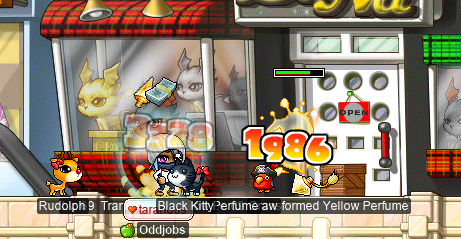
Like… a thousand perfumes.
Whilst I was busy perfume-punching, I noticed something:

Hmm… Just… a URL? Gosh, I can’t imagine this aged well. Let’s try pointing a web browser at http://tw.maplestory.gamania.com…
Well, at the time of this writing, the DNS request succeeds, giving me an IP address; however, attempting to negotiate a TCP connection to the usual HTTP port (viz. port 80) doesn’t get any response. Tragic. I’m not going to be rude and port scan them or anything like that, so we’ll stop there.
But we can still use archive.org’s handy-dandy Wayback Machine! Let’s see if there are any archived versions of this webpage… A-ha! It seems that this website was last online somewhere between 2013-06-16 and 2013-06-28, and was first online at least as early as 2006-04-05. Wikipedia claims that Gamania acquired the licence for MapleStory some time during 2005; although there’s no source material to back this up, it would make a lot of sense with the first appearance of the TMS (Taiwan MapleStory) website being around early 2006-04. I’ve never played TMS myself, but it appears that Gamania brought several popular online videogame titles to a Taiwanese audience, including not just MapleStory, but also Lineage[1], Crazyracing KartRider[2], etc. All aforementioned games were made by South Korean developers, but Gamania has also released their fair share of original titles. They also used to have a subsidiary in South Korea, and continue to have subsidiaries in Hong Kong, Japan (Tōkyō), the PRC (Běijīng), the U.S.A. (Irvine, California), and the Netherlands (Amsterdam). Gamania is natively known as 遊戲橘子 ⟨Yóuxìjúzi⟩, literally “game orange [in the ‘fruit’ sense]”.
At the time of this writing, the English Wikipedia article on Gamania features this little gem…:
The company’s F.A.M.I.L.Y. slogan stands for Fun, Adventure, Mind-Inspiring, Innovation, Laurels, Youth. It is possibly the worst slogan in the history of marketing.
Gamania shut down their South Korean subsidiary at the end of 2012, so perhaps that has something to do with this website going offline not too long after. Nevertheless, TMS is still ultimately run by Gamania, under the brand name beanfun!; the TMS website (at the time of this writing) can be found at https://maplestory.beanfun.com/main. The earliest archived version of http://tw.maplestory.gamania.com can be found here, which I think is pretty representative of what it was intended to look like.
Anyways. I still need like 200 more perfume ETCs…

Whew, okay. 600 perfume ETCs, done & done. Sheesh. That means it’s time for some Cheap Amps!:

And, of course, their more luxurious cousins, the Fancy Amps:

Ah, but it is time to interrupt our Taipei 101 hunt in order to take care of some lingering unfinished business… That’s right; PPQ. Remember how, in the previous diary entry, I said that I was probably not going to be able to finish all of the PPQ quests? Because they suck ass? Particularly Eliminating the Pirates?? Well, I’ll be damned if I didn’t try anyways:
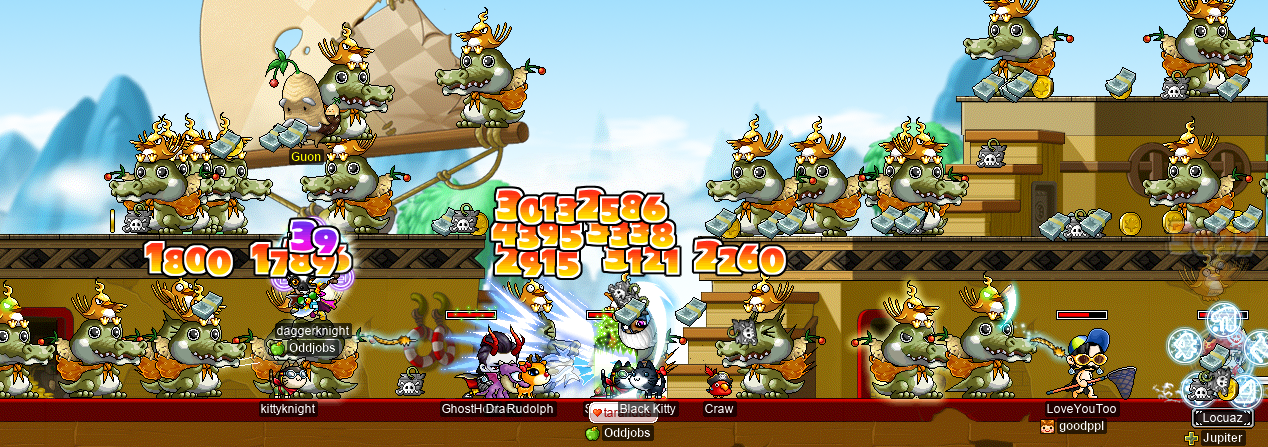
In the image above, you can see me at PPQ stage 2, alongside Locuaz, LoveYouToo, GhostHost, SlothGoth, and daggerknight (Gumby, Jonathan, Kimberly). I was, quite frankly, truly blessed to have this party. LoveYouToo is actually a STRginner; daggerknight is, of course, our resident dagger DK; Locuaz is so stronk that he makes Devoted Captains look like Red Snails; and SlothGoth & GhostHost are questers! We love questers!! I love running into the occasional random guildless quester at OPQ, PPQ, or MPQ. I don’t know how rare they actually are, because there’s no reason that you’d ever run into one and know that you did, unless they join your PQ party in search of a quest completion…

Anyways, the party was so blessed that I was able to finish every last PPQ quest! They even reminded me about the hidden PPQ quest that I’ve done at least two or three times before, and somehow still forgot that it exists!! In particular, this is the Captain Lord Pirate quest, which can only be started if you’ve already obtained Lord Pirate’s Travel Diary, which randomly drops from some of the chests scattered around the various PPQ stages.
Honestly, big sigh. Having all of the PPQ quests and all of the MPQ quests done is a load off my mind. And no, I still don’t care that I skipped The record of Goddess Minerva. That quest can kindly feck off.
So, that brings me back to TP101; this time, to kill Kid Mannequins!:

I feel like this quest is foreshadowing for something that I’m going to end up doing later on this character… 🤔
Anyways, I gotta do the Male Mannequins as well:

Oh, boy. I forgot how much Male Mannequins suck ass. Long ago (extra brownie points if you remember this shit), I actually used to train here on my woodswoman capreolina. It was a very different time. I died a lot. I used a lot of goddamned Barbarian Elixirs. These things hit hard, and then they immediately empower themselves so that they hit even harder. Sheeesh. Oh, and I had a few accuracy issues. 🤦🏽♀️
It wasn’t too bad, though. Eventually, I had enough fedoras for the quest, and it was time to finish this thing by farming Female Mannequins:

Ahh, excellent. Now, it is time to claim my prize. The reward for this questline is somewhat special; as far as I know, it’s the only way to obtain Beige Umbrellas. Furthermore, you also have a chance of getting a Black Umbrella instead. Both great gish-y weapons! Let’s see what I get…

🤦🏽♀️🤦🏽♀️🤦🏽♀️ COME ON, JERRY!! No, I do not want the level 8 umbrella that drops from Crows!!! Ugh. Oh, well…
Let’s move on over the Masteria, and do some of those quests instead. I’m level ≥80 now, so I can actually finish the Silver Deputy Star questline. To do that, though, I would need to fight Bigfoot for its toe. I don’t think level 83 tara is ready to fight BF yet…
That’s okay, though. I can just farm a toe for myself, right? So, I hopped onto my darksterity knight rusa to solo some boyfriends Bigfeeties:
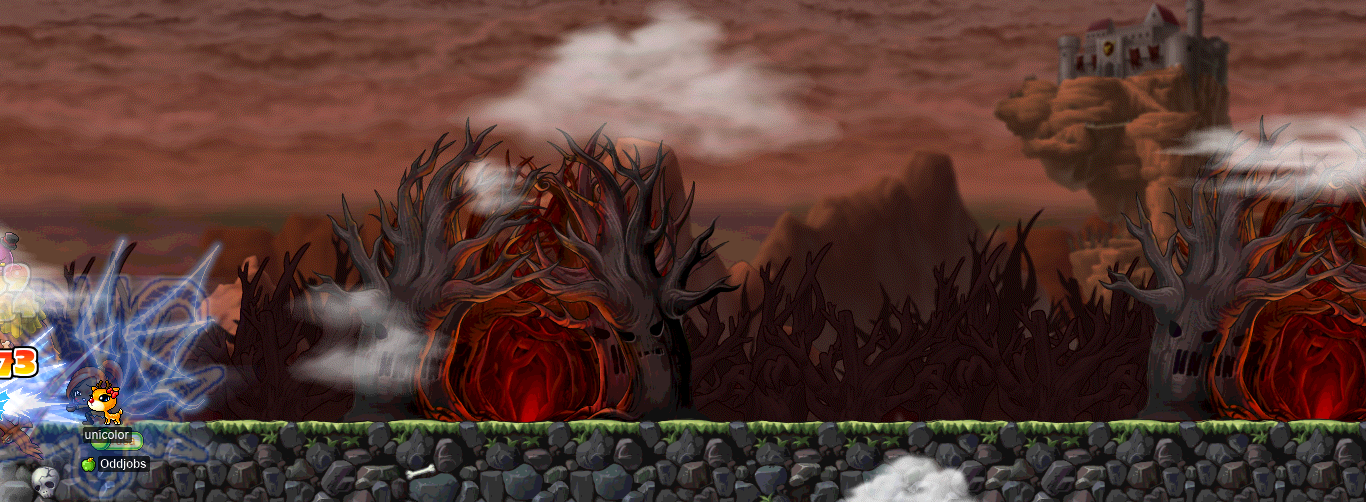
The first one didn’t drop a toe, unfortunately, but hey — at least it dropped a card!:

So, I found another one. Soloed that one too… only for it to drop a big fat stack of like 13k mesos. That’s it. -_-
For my third attempt, bowmaster Jestterzz (Jestterz) came to assist me in a duo BF fight:
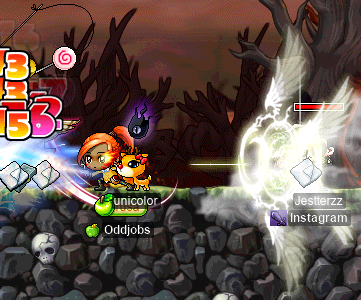
And, lo & behold, the third time was indeed the charm! Toe acquired!! Level 84 acquired!!!:

Now, it’s time for the real Masteria shit. Like the level 80 quest, Urban Jungle, which had me slaying Wolf Spiders:

I have a distant memory of getting to the rank of marauder for the first time in my Maple career (on a far-away server, long, long ago…), and being told that I should go to NLC to train on Wolf Spiders. I did, and I died. Several times. A little dispiriting… Now, though, I know what I’m doing! I didn’t die even once!!
I made sure to also complete the repeatable version of this quest. Because the repeatable version gives different rewards, it’s a separate quest, so I really do have to “do the quest twice” in order to complete it fully.
With that done, I was starting to wonder where in the got damn hell my Warrior Throne was. After some searching around the interwebz, I became really confused as to how I’d not even completed the Featherweights quest. I mean, I don’t really remember having done it on this character? And it doesn’t show up in the “Completed” tab of my quest journal…? But, I mean, come on; it’s a level 50 quest, so surely I would have completed it by now.
I was then politely informed by the people in my alliance chat that the Welcome to New Leaf City Quiz is actually a hidden quest! Despite being a level 15 quest, I had just never done it, because the lightbulb thingy never shows up above Icebyrd Slimm’s head, and it never shows up in the quest journal!! Armed with this knowledge, I was able to quickly do the quiz and continue on to start Featherweights. For this, I would need a few more Boomer Cores:

Plus, I would have to go back to Gryphons again, to kill even more of these, in addition to the 200 that I killed for Cleaning Up the Streets long ago…:

And there we have it! Warrior Throne acquired!!:

There are still some more Masteria quests on my list, but at least two or three of them are just not doable for me yet — I’ll have to wait until level ≥100 or so. That being said, there was one quest that I was ready to do: Mark of Heroism. For this, I would need four (4) Typhon Feathers, so it was time to climb…
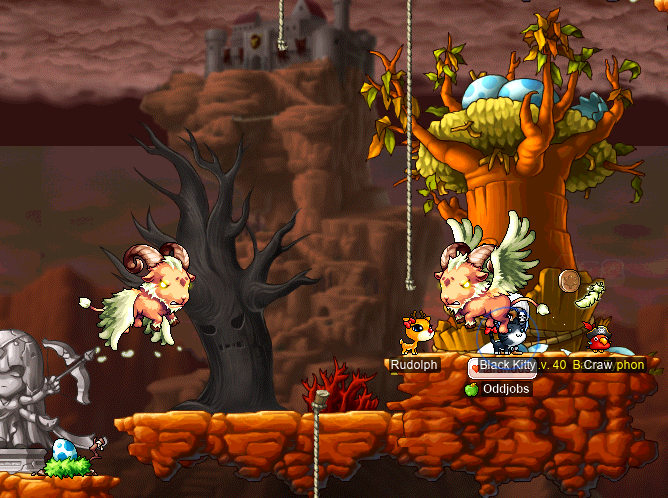
Yes, yes. Farming Typhon Feathers from Baby Typhons, just like the Phantom Forest crafting days of old…
Stay tuned!!
Footnotes for “tarananana”
- [↑] Lineage also features in my previous diary entry.
- [↑] R.I.P. KartRider for Western audiences. The English-language “global” port (basically the KartRider equivalent of GMS) was around for a brief time in late 2007 to early 2008, but it just kinda vanished and that was the end of it. Too bad for the people who liked it, I guess. Fortunately for those people, however, it seems that there’s a new KartRider game? Released just four days ago?? Check KartRider: Drift out, I guess…
What is a “mule”?
I don’t really do mules; I don’t have buff mules, nor any of that multi-mage shit. I do, however, have quite a collection of PQ mules. These are “mules”, but are played more or less like ordinary characters — with the caveat that they never gain EXP. Thus, I’ve featured all of my PQ mules multiple times before, within this very diary.
I’ve been getting a lot of use out of my OPQ mule, sets, as several of the members of Oddjobs have been making their way through the OPQ levels. Here I am, fighting Papa Pixie alongside Dakota the cowgirl:

And again, alongside vvvv (inject, inhale) the DEX brawler:

Ah — but there is a new generation in town! Meet the daggerbros, inject the dagger fighter & daggerknight the dagger spearman! You can see them both below, fighting Alishar alongside my DEX brawler LPQ mule sorts, brigand Weakling, and cleric Roivas:

We were later joined by brigand Hitodama (Taima, Boymoder, Hanyou, Nyanners, pilk) and DEXdit breakcore (xX17Xx, drainer, attackattack, maebee)! Below, you can see us all doing stage 8…:

…And fighting Alishar:

Now that I was getting some more play out of sets, she finally hit the big level 70~! The highest possible level!!:
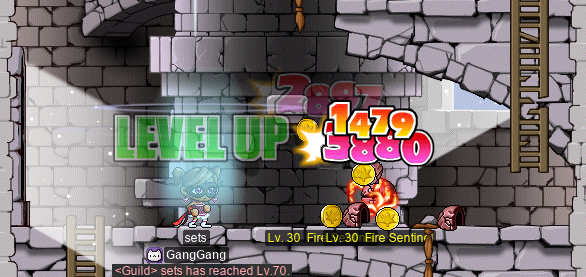
You know what that means: it’s hermit time!

Regrettably, I can never have Flash Jump, as it requires level ≥5 Avenger. But, you know, level 1 Shadow Partner ain’t half bad…

Wowie! Actually quite a bit of extra DPM, and it lasts long enough for one entire Papa Pixie fight! :] You can also see the daggerbros in the image above.
Because I decided to just go the pure LUK route with sets, her best bet for a hat is pretty much the Ravana Helmet, as hats cannot be scrolled for LUK. So, I decided to do the Rāvaṇa prequests on her, and try to get her a helm…
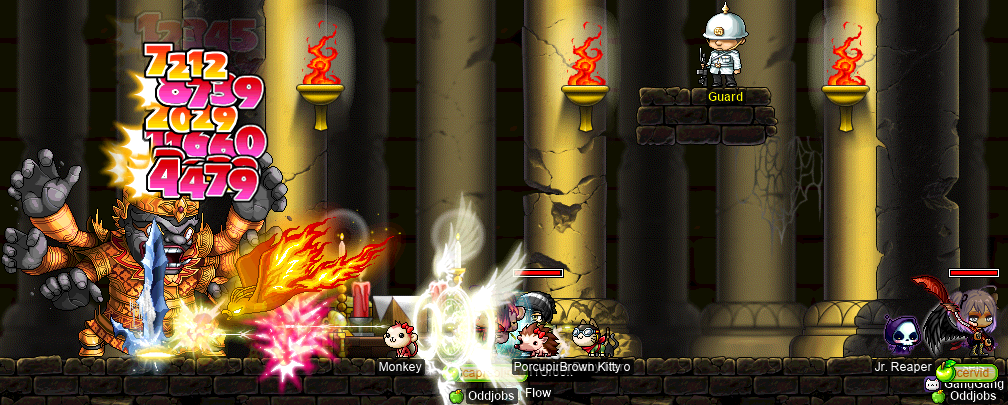
And, holy shit, I actually got a real helmet on the first try???:
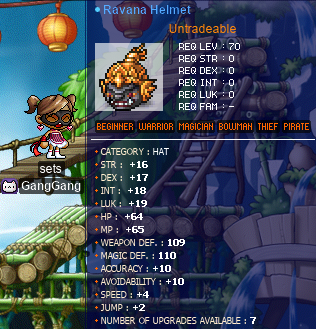
That’s some serious luck right there. Remember when it took me like 21 tries on rusa? Sheesh… And the LUK is only 1 below perfect, too! That’s a keeper.
I also helped out baby cleric PriestjuhNL once again, this time on sets, at OPQ…:

And I even got to MPQ with the daggerbros on my F/P MPQ mule potpan!:
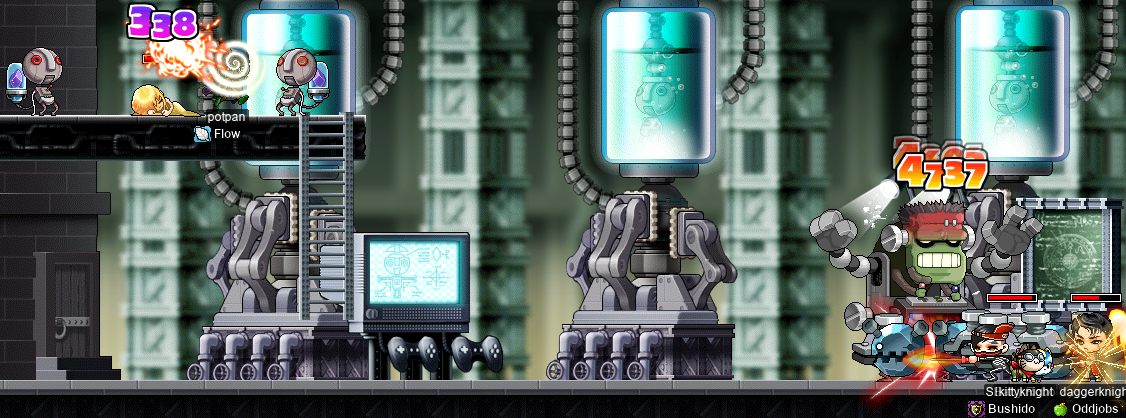
Holy moly, they grow up so fast…! :']
What do I do with all these coins?
Anyone who does Neo Tokyo content is familiar with the fact that most Neo Tokyo (“NT”) stuff gives you Silver Coins. These lil guys stack up to 9 999 per ETC slot, and are commonly referred to as simply “NT coins”. They’re also untradeable. So, you know, what can you actually do with them? Well, you can do NT crafting! I recommend consulting Zooploop’s Neo Tokyo Guide (archived) if you want to know the details, but basically, you can craft stuff like:
- Magic Throwing Knife (“MTK”), the most powerful throwing star in the game.
- Armor-Piercing Bullet (“APB”), the most powerful bullet in the game.
- Element Pierce (“EP”), the most powerful earring in the game.
- Judgement, basically the second-most powerful gun in the game, because Timeless/Reverse Blindness can be obtained from Pink Bean.
- Speargraves & Flairgraves (collectively “graves”), which occupy a similar place to the Judgement, but for other non-gun weapon types.
So, yeah. Pretty powerful stuff. But in order to craft them, you need a bunch of crafting materials, which includes NT coins, amongst several other things that aren’t so easy to get your hands on. Furthermore, in order to talk to Noran, the NT crafting NPC, you need to get to 2102 Akihabara — Command Room. That implies having at least progressed past the NTPQ (Neo Tokyo Party Quest) part of the questline.
Thus, it’s not terribly uncommon for players to sell NT crafting services. The seller provides the NT coins, and the access to Noran, which is what the buyer is paying for. Then, the buyer also provides the rest of the materials. Once the craft is done, the result is given to the buyer. Simple as.
Our resident INTlaw Lvl1Crook (Level1Crook, xXCrookXx) has bought such a service several times in the past, to craft Judgements. Previously, he bought from Nightz, but now there’s a new seller in town: me!! I haven’t used any of my NT coins on my darksterity knight rusa up to this point, so I’ve got like 13 or 14 thousand by now. You know what that means…

Unfortunately, it seems that I have shitty peepee poopoo crafting hands, because this was the result…:
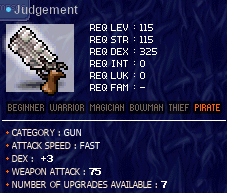
Oh, my god. It’s literally the worst possible stats. I’m so sorry, Lvl1Crook…
Side grinder
I also did a good bit of grinding on my I/L archmagelet cervine, thanks to a couple of grinding partners that I had, and a GM buff here or there! Here I am at CDs with STRginner Gumby (daggerknight, Jonathan, Kimberly):

I do take up a lot of space at CDs these days, what with the Blizzarding & all that… Of course, casting the damn thing just once takes most of my MP; even with HB, I’m just shy of having the MAXMP to cast twice without repotting!
But then… disaster struck……

MY XMAS NX CLOTHING — GONE? EXPIRED?? HELLO??? What the FUCK am I supposed to wear now????
Ahem. It’s okay, I’m fine. I’m… sure I can get it back… this Xmas event…… if it ever comes………
In any case, I managed to compose myself just long enough to kill some Himes with marksman Level1Crook (Lvl1Crook, xXCrookXx)…:

And, later, I even managed to level up to level 126 at CDs!!:

:3
Speaking of grinding, I duoed 7 F alongside Level1Crook, on my darksterity knight rusa, which marked Level1Crook’s first time ever at 7 F:

If you thought Himes was bad enough, it’s time to come out of the frying pan into the fire!! 7 F was a real workout for our poor Level1Crook, who patiently grinded with me here for all 60 minutes of my GM buff. I don’t think that he’ll be coming back any time soon, though…
Spiky coda
My darksterity knight rusa is back at it again with the Horntailing!! Let’s see it!!!
I tried measuring my DPM at preheads again, doing a @dpm 2 with HS:V, Echo, MW20, SI, & SE:

1.76M single-target DPM. Nice. :]
Here I am, attacking mid head from the right-hand side in a 12-Mapler run; you can also see shadower Harlez (Murhata, VigiI) and hero SmallMight (SiriusPlaque):

I saw a smega looking for a last-minute seduce target for Horntail, and I decided to reach out in case there really was a shortage of sed targets. I was thus signed up for one of Diggy’s HT runs, as sed target! And with level 200 bishop TheNarrowz as my sed bishop!:

I was fairly confident, especially as I have run with TheNarrowz several times before, but I will say that my ass is pretty much clenched like 80% of the time LMAO:

I pretty much know my technique now, though. This is not my first rodeo, and I even did a fairly in-depth analysis of DEX DK as sed target in pt. xc of this diary. I now behave roughly like you would expect an ordinary shadower sed target to behave, including attacking from HT’s sides:

The particular position that you see me in in the image above is especially advantageous damage-wise, as it allows me to damage three targets with each Crusher (assuming that the right head isn’t weapon-cancelled). In fact, it’s worth taking a look at the two positions that you’ll mostly find me in as a sed target during the main body fight.
Because I don’t want to make things unnecessarily dangerous by constantly threatening myself with touch damage, standing too far from the nearest rope (a rope that would help me to not take touch and/or falling rock damage), and standing far away from my bishop, I tend to either be on the middle-left (as opposed to upper-left) or the middle-right. I don’t really hit the heads — with the obvious exception of right head. This might seem unfortunate, as the heads are the truly dangerous part of Horntail after the initial part of the fight where the legs & tail are quickly taken out. Furthermore, you might have vague worries about accidentally triggering mass seduce by hitting either arm too much. Don’t worry, though — this is all standard procedure. Shadower sed targets hit wings/arms as well, with the understanding that they are the only one doing this consistently. Everyone else is focusing on the heads, only attacking wings when heads are all cancelled (or the nearest two heads are both cancelled). Furthermore, note that I said “wings”; ranged attackers don’t end up hitting the arms much anyways, at least whilst the wings are still alive to protect them by acting as a fleshy shield.
The point is, I basically have two different positions, once the legs & tail are down:
- On the left-hand side, I stand on the little lower island platform so that I can hit the wings and the left arm at the same time. I generally try to stay as far towards the left edge of this platform as I can without “whiff”ing, because that keeps me closer to the nearest rope, which is on the larger platform that’s to the left & above.
- 👍 My bishop has a pretty easy time saving me if I get into trouble from this position, as it’s quite low to the ground, rope included.
- 💩 I mostly hit just two targets at a time here, although I may occasionally get a hit in on the left head if it cranes its neck down.
- 💩 Getting to the rope in time, before seduce actually takes hold, can be a bit tricky from this position. I generally do a good job of it, but it’s somewhat stressful, especially because it requires jumping somewhat carefully. Thankfully, being close to my bishop makes it not so risky here.
- On the right-hand side, I stand on the little island platform that is in between the other two little platforms that are on the right-hand half of the map. Positioning here isn’t too finicky, but I do have to make sure that I’m far enough left to hit the arm consistently.
- 👍 I mostly hit three targets at a time.
- 👍 Getting to the nearest rope is very easy.
- 💩 If I’m roped & in trouble, my bishop is unlikely to be close enough to assist me. Thus, this position is actually a bit scary.
The one unfortunate bit is really just that I lack Dark Sight; as a result, I live in mortal fear until the tail is killed. Thankfully, killing the legs & tail takes up just the first bit of the main body fight, but there’s a problem: if the legs are still alive (like at the very beginning of the fight), then I can’t really attack. My defence against walking into tail (which hits for a lot of touch damage, especially if empowered) is being roped, but if I get stunned by legs (the only body part that can stun) immediately before getting seduced, then I don’t have a way to get onto a rope in time — I’m too stunned for that!
In any case, here you can see me jump seduced just barely underneath the little island platform on the left-hand side (where I’d normally be standing):

And here, you can see me rope seduced just above the little island platform on the right-hand half of the map (where I’d normally be standing):

And after two runs, I felt great! Not even a single death!! And TheNarrowz did a great job with the pog shields!!
Another day, I ran with another of Diggy’s “drunk HT runs”, this time as just a normal attacker. During round 1, we had a shadower as our designated sed target, but Diggy was just slightly too tipsy to remember that the sed target had to enter the main body map first…:
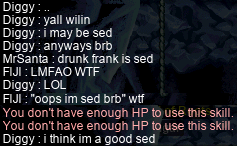
(Note that the final message in the screenshot above was from nearly the end of the fight; I just stitched the two screenshots together.)
Although he did die once at the beginning, it wasn’t too bad once his bishop helloooo instructed him on how to look for the seduce animation. Because Diggy is a nightlord, he still had Shifter and lots of special-sauce thief AVOID on his side. Not only are non-odd thieves approximately pure LUK, but they get a special avoidability formula that no other classes get, effectively making thieves a cheat code for extra avoidability…
This island
Tired of Horntail? Welcome! To Maple Island!! I did some GM buff grinding on my islander ozotoceros alongside fellow islander SnailDEX, duoing Pigs for the first time in… I don’t even know how long:

I do play my islander from time to time, but I don’t usually include it in my diary entries, because it’s usually just me hitting shit at DF or whatever. So now, with just a bit more EXP under my belt, it was time for ozo to hit level 47~!:

Yey!! Just one more level for that Blue Valentine Rose, I guess. :P
That island
Oh, but what about the other island? You know the one. The other one. No, not that other one. That other one.
I did some APQing on my vicloc dagger spearwoman d34r, including this one with DEX brawler vvvv (inject, inhale), cowgirl Dakota, and STRginner Gumby (daggerknight, Jonathan, Kimberly, Mommy):

Here’s another one that I did with marksman Level1Crook (Lvl1Crook, xXCrookXx), STRmit Boymoder, Dakota, shadower misoso, and corsair ToasTea (the latter two I already knew from Horntailing):

Here I am in another APQ run, soloing Grog’s first body…:
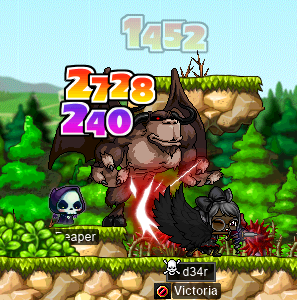
I ended up duoing this Grog fight with bishop Clak:

It was a tough fight, but we made it in the end!! It was a bit weird having to ask for Bless every time that I got dispelled, but you know how it is…
I also attended a “bomberman” GM event. I went to this event for the first time back in pt. xlviii, and this time, I got to see the same wacky visual glitch again:

That’s one heck of a barcode…
I also did some FoG grinding alongside Boymoder and my vicloc husband xXCrookXx…:
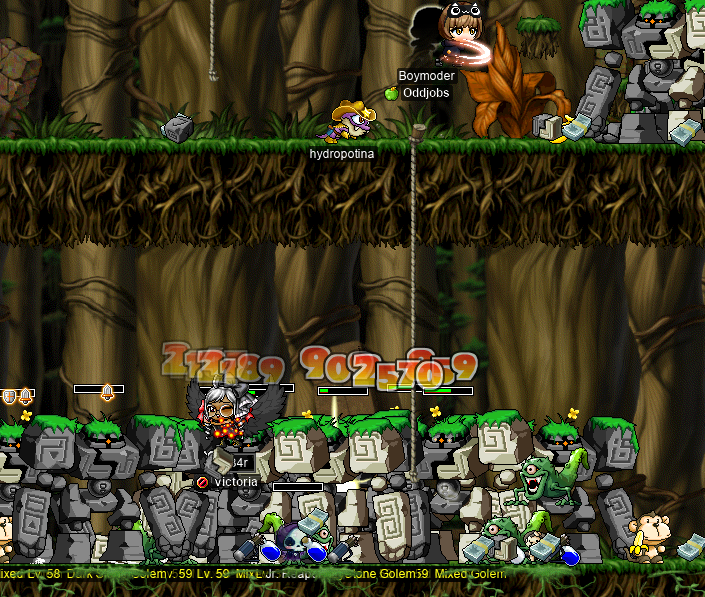
During which, I hit level 89~!!:

CB, indeed.
And finally, I did a couple of osslock-friendly (read: no 4th-jobbers!!) APQs, like this one with ranger Mekhane (Sunken), marauder Phister (Flai, FIai), dragon knight yeIlo (bak2monke, VAPORWAVE), Gumby, & crusader Qmix:

“What?? No 4th-jobbers??? HoW WiLL u kiLL tHe boSs?!?!?!?!?”
Easily done (also feat. I/L mage Kettricken (Keppet), white knight Buppoon (Buwwon, Bushroom), & chief dit ULTRAdragon7):
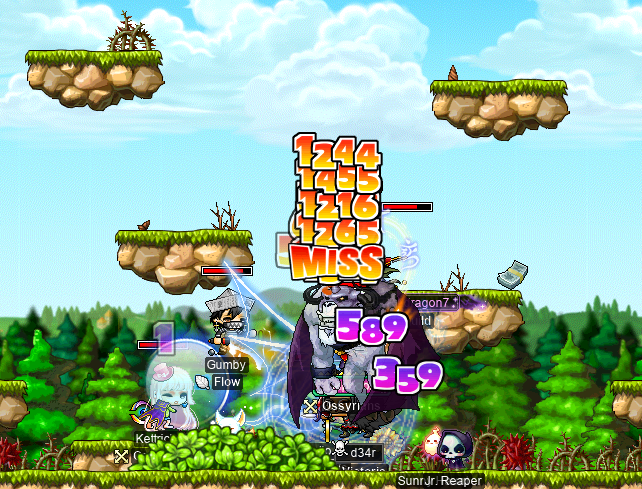
😎
Bossy wossy
On my woodsmaster capreolina, I helped out permarogue xX17Xx (breakcore, drainer, attackattack) with her Papu prequests so that we could get that Pap goin’. First up was hunting Tachions over in FPoT1:

Then it was time to slay some MDTs for their precious Mysterious Powders:

To hunt for pieces of crack, we headed to Forbidden Time to dispatch the GPWs there:

And, last but not least, to Forgotten Passage to get a Ludi Medal:
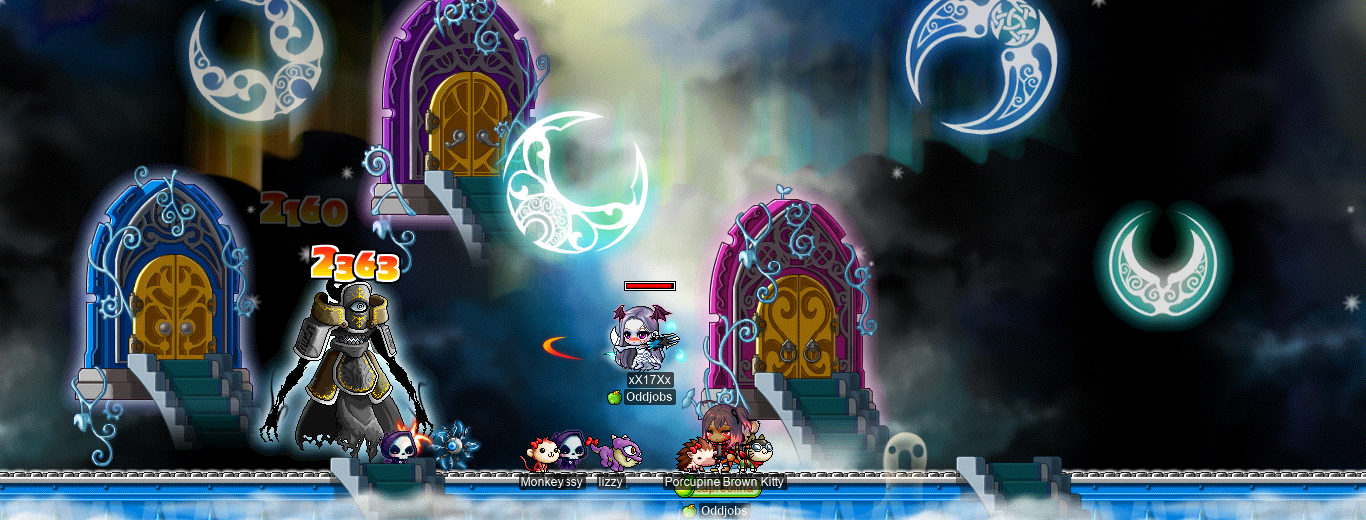
(Can you tell how much I like Deep Ludi’s visuals yet?)
And then, it was indeed time to get the Pappin’ goin’! For xX17Xx’s first-ever Papu, we went with DEX WK SwordFurbs (Yoshis, Furbs, SwordFurb), marksman Level1Crook (Lvl1Crook, xXCrookXx), with me playing on my darksterity knight rusa:

And for round two, we were also joined by paladin SaviorSword (dressed in full level 15 warrior gear), and SwordFurbs switched over to her swashbuckler Yoshis:

Pretty fun stuff for a first pair of Papu runs!!
Over in the mines of hell Zakum’s steamy lair, I hit level 146 on capre during a Zak run!!:
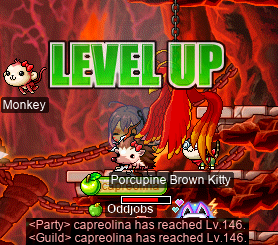
I was curious about the kind of uninterrupted single-target DPM I was getting against Zakum’s body. When I say “uninterrupted”, I mean that I’m really looking for the DPM regardless of weapon cancels. This is emphatically not the same as a more typical @dpm 25 that you’d start at the beginning of a Zak run — I want to do this kind of test as well, but I did this quick-and-dirty one first:

The above recording is of a @dpm 2 that I snuck in during Zakum’s 2nd body. I tried a few until I could get one that didn’t have any weapon cancels in it, and I made it fairly realistic/bare-bones by just having MW20, Rage/Cider, and my own SE. 1.41M ain’t so bad for bare-bones single-target DPM against a reasonably-high-WDEF boss, I think! Maybe…!
Ahh, but what about our old friend Krexel? I did a @dpm 3 against its right eye with the same buffs — plus Echo — and got this:
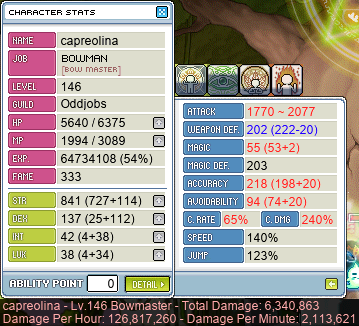
Whew. That’s a lotta damage! A decent chunk of the difference here between the Zak 2nd body DPM and this Krex right eye DPM is actually my birdy, who gets to attack uninterrupted against Krex right eye, but not against Zak body. Also, probably a decent chunk is that my attacking is truly uninterrupted in this case. Anywho, I am pretty pleased with a 2.11M. :]
rusʹ
Oh, and it wouldn’t be another instalment of Bossin’ With deer without people freaking out because rusa’s at 1 HP, would it…?:

I also did Jiaoceng with a different group, this time with bowmaster xRook (misandrist) and shadower NoChorus (Sakuzyo):

I got Echo of Hero and popped an MMF (+37 WATK, +77 AVOID, etc., for 10 minutes — just long enough for a single JC run!) for the first round, hoping that this would ensure a victory. Regrettably, it… did not. Humbled by our initial failure to finish within the 10-minute timer, we decided to just Onyx Apple for the second round, which did the trick. :] It was definitely a tad bit overkill, but hey — we learned a lot…
Over at Zak’s altar again, but this time on rusa, I did a pair of Zaks with shadower Shanaz (Alectra), bishop Wook123, I/L archmage Antheaa, and marksman Scoobii. It was during these runs that I started experimenting with a new technique. You see, I’ve done a lot of Zaks now on rusa, so I have a pretty good feel for it, having refined a technique that allows me to maximise the amount of DPM that I do to Zakum whilst still keeping HB/IW up on all of my party members at all times, and also reducing my risk of dying to essentially zero. Basically, it looks like this:
-
I set my autopot like so:
- HP threshold: 15% (4.5k HP).
- HP potion: Triangular Sushi(plum).
- MP threshold: 5%.
- MP potion: Sorcerer Elixir or similar (e.g. Mana Elixir).
-
I make sure to have all of the following buffs up at all times, unless replaced by superior buffs:
- HB.
- IW.
- Spear Booster.
- IB.
- Power Stance.
- MW20.
- Cider/Rage.
- Archer Elixir/Bless.
-
When we go inside, I try to get in as many HBs as I can that will hit all of my party members, so that I can attack as soon as the arms spawn without having to rebuff for a while. Keep in mind that HB only lasts for 155 s (i.e. 2 minutes & 35 seconds), which is not even much longer than HS. It might seem weird that I’m a bit anal about keeping my buffs up on everyone all the time, but I consider it to be part of my job, and I know that I appreciate it when I’m, for example, fighting Zak on capreolina in a party with a DK.
-
Starting when arms spawn, I stand on the lowest of the platforms that are on the left-hand side of the map. I use Rush to position myself on the far right edge of this platform, and try to uninterruptedly spam Crusher as much as possible. This position causes me to hit arms 1 & 3[1] consistently, and also to hit arm 5 a solid amount of the time. Thus, I hit something like ≈2.5 targets from here, which is basically optimal.
One thing that I have to worry about here is being knocked off, which usually means being knocked rightwards, forcing me to go back left, climb the rope, and then Rush again to reposition. Also, the arms here spam debuffs, so I have to quickly ACP as soon as I’m afflicted by Darkness, Seal, or Curse. The ACP part is actually more difficult than it sounds, as getting the game to register that you pressed the ACP button on your keyboard is somewhat of a feat in & of itself…
-
When I need to rebuff, I usually jump down, run rightwards — buffing as I go — climb up to buff the ranged attackers, and then use the teleporter to go back to the left-hand side of the map. In rare cases, I can minimise walking by using the teleporter both ways, but that only works if my party is positioned in a certain special way.
-
I usually stay in this position until both arms 1 & 3 are dead or nearly dead, unless I can clearly see that some other arms (e.g. 4 & 6, or 6 & 8) are a better use of my DPM. If only one of 1 & 3 are alive, then I’m only hitting like 1.5-ish targets here.
-
If I’m lucky, I can get my buffs on everyone just before first body spawns. But often, people are split up all over the map even with only one arm left alive. If the latter is the case, I usually follow everyone over to the left side of the map, making sure to buff everyone once before going over to the right side of the map all by my lonesome.
-
During Zak’s bodies, I’m mostly on the right side by myself, so that our bishop can Heal freely. Indeed, I’m so used to doing it this way that I do it even if we don’t have a healer; but we’ll see that Heal is certainly not the only reason for positioning in this way.
There’s a bit of a smol bump in the ground terrain on the right side of the map that I can use to position myself. By being on the left half of this tiny bump, or being just to its left side, I am roughly as far away from Zak as I can be whilst still hitting the body with all of my Crushers. Note that this is not how most DKs do it; most DKs will position themselves very close to the body, allowing them to easily touch the body any time that they need the iframes necessary to avoid getting stunned by a stun pillar. My technique still dodges all stun pillars, but without endangering myself by being unnecessarily close to the body whilst zerking as hard as possible. Rush still works here (i.e. I am close enough to the body to target it with Rush), but you might wonder how this helps to dodge the stun pillars; after all, what if a stun pillar is going to land where I am, but also where I would be if I Rushed? The answer is simple: Rush gives iframes. By timing Rush somewhat carefully, I avoid taking damage entirely; I do not touch the body, and the stun pillars cannot connect with me either (although it visually looks like they’re going to).
When using this Rush technique to avoid getting stunned, I am extremely conservative with my HP. I keep track of what body of Zak we’re on, consider what the maximum amount of damage is that I could take by touching it, and make sure that I have at least a little bit more than that much HP when I Rush to dodge pillars. This might seem redundant; after all, part of the benefit of my technique is that I don’t take damage at all, including not touching the body. The redundancy is intentional. On the one hand, this never results in my HP being very high, as the worst case (third body) “only” deals like 8k〜9k touch damage to me. Thus, I can still zerk with great effectiveness, especially considering that I don’t usually have to Rush super frequently. On the other hand, by introducing this redundancy that potentially slightly lowers my DPM[2], I get a huge safety cushion in exchange: even if I lose track of my exact position and accidentally Rush into the body (e.g. if there happen to be a few summons flying around me at the time), or whatever — any mistake and/or inaccuracy — I basically still cannot die. Virtual invincibility is the kind of trade-off that I’m willing to make here, as a dead DK does 0 DPM. Thus, my technique is actually highly conservative, despite zerking quite hard and dodging all stun pillars.
Having good AVOID also helps me here, as it means that I get Sealed less often, and I’m more resilient to mistakes/inaccuracies like failing to dodge a pillar, or accidentally forgetting to pot — or, much more likely, potting & having the game ignore my keypresses, or having the server fail to have a low enough networking delay to raise my HP in time, or anything like that…
-
When my HB starts getting very low on remaining time, I know that I have to rebuff myself & everyone else at the same time. I typically pot up and Rush across the body, simply walking through it to the left side of the map. Once everyone has HB & IW, and I have any buffs of theirs that I need (SE, SI; stuff like that), I use the teleporter to go back to the right side.
It might seem weird that I walk through body from right to left, but instead use the teleporter when going from left to right. The reason for this is simple: by climbing up and using the teleporter on the upper-left corner of the map, I can aggro the summons as I go back into my position. I usually give a single roar somewhere on the upper platforms of the left side in order to aggro the monsters that might bother the rest of my party, and then sometimes also give a roar or two after having used the teleporter, so that I’ve gathered up all of the summons on top of me. This is an absolute no-go if I were to position myself on the left-hand side of the map (e.g. in the absence of a healer), and also a no-go if I want to walk back to the right side in the same way that I walked from right to left; in either case, I would basically be griefing all ranged attackers by moving the summons in front of them and/or on top of them. Instead, this technique gets rid of the summons without dragging them in front of anyone, so that I can deal with them by just attacking Zak from my position normally. My Crusher hits up to three targets per attack, so it naturally cleaves through any summons that get too close to me. Plus, it sometimes lets me dodge stun pillars without having to Rush, just because the summons’ attacks give me iframes.
In order to pull all of this off with great effectiveness, I have to be fairly attentive, and I have to know Zak’s animations by heart. For some reason, however, I decided to make it even more difficult for myself: what if I memorise Zak’s summoning animation, and charge up my Monster Magnet (“MM”) any time that I see the beginning of such an animation, so that I can pull the summons towards me the instant that they spawn? I dunno, let’s try it:
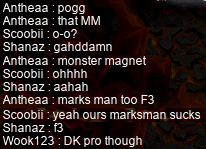
It was well-received!!
I will say that this brings my technique to the point of slight overload; it’s so involved at this point, that I am virtually guaranteed to make a significant number of mistakes. For example, when I use MM, I have to immediately use Fury at least once or twice. If I don’t use Fury in this way…
- …and the summons are Boogies: I will probably get stunned by the Boogies, because I didn’t kill them fast enough. Not the end of the world — still better than someone(s) on the other side getting stunned — but still not good.
- …and the summons are not Boogies, thus being flying summons of some kind: they have a good chance of fucking off immediately after being MM’d. MM seems to not aggro monsters consistently, so I need to actually hit them with a real attack before I can go back to Crushering.
This is all fine & good if I’m quick enough on my keyboard, but sometimes I have to make a trade-off: Zak seems to like dropping stun pillars immediately after summoning, which means that I am condemning myself to the inability to dodge stun pillars if I decide to do this. Again, it’s a trade-off, and I usually prioritise aggroing the summons over dodging stun pillars. Why? Well…
- If I’m somewhat lucky, the stun pillars won’t even target me.
- If I’m quite lucky, I may get iframes at the right time from one of the summons, thus dodging a pillar that would otherwise strike me.
- If none of the above occurs, but I’m still somewhat lucky, a stun pillar will connect with me but fail to penetrate my AVOID.
- In any case, I’m prioritising my DPM somewhat lower than that of the rest of my party.
There are other subtle issues too, and also not-so-subtle issues like “what if Zak starts aggressively spawning strong summons?”. I can’t keep the whole thing under control all of the time, but I merely try to be as useful to my party as I possibly can muster.
In other news, I got the chance to try fighting Aufheben for the first time!! I went with shadower Harlez (Murhata, VigiI), bowmaster Flurri (SecretIy), and hero Pascalieboy (who was also a first-timer), on a trial run just to test it out. I recorded almost the entire thing, and you can watch a lightly-edited version on the Oddjobs YouTube™ channel!:
What is an “Aufheben”…? (feat. rusa) [YouTube™]
As I said, I recorded almost the entire thing. I was the second-to-last to die, and I missed the part where Harlez died not too long after me, because I stopped recording when I died. :P
In any case, this trial run was a big help to me. As many times as I may have watched Linny’s Aufheben guide, nothing is a replacement for actually getting a feel for it. Unfortunately, Aufheben is no different from the rest of Neo Tokyo 2 in that it is very hostile to DKs; DKs simply are not very useful in comparison to other classes (although they should nevertheless not be underestimated), and Aufheben makes that clear by essentially banning you from zerking, and also constantly dispelling your party buffs nonstop. Nevertheless, there’s some amount of finesse that can be had by playing carefully and knowing Aufheben’s abilities, so perhaps one day I will be able to wear a circlet of my very own! That’s the dream……
Footnotes for “Bossy wossy”
-
[↑] Numbering arms from left-to-right, and then top-to-bottom, like so:
left right 1 2 3 4 5 6 7 8 -
[↑] The new MapleLegends version of Berserk gives at least some increase in damage for each HP that you lose — just not much beyond a certain point. The loss here is basically negligible, particularly because I make up for some of it by refusing to use AotB. For more details, see the “Berserkr” section of pt. xc of this diary.
A rare spotting of P. eldii
Some of you may remember my dear permarogue, panolia. My first character that I ever experimented with HP washing on! Well, with xX17Xx (breakcore, drainer, attackattack) playing the role of “grandmaster permarogue”, I haven’t really bothered much with mine. :P Nevertheless, with the occurrence of a certain event that we’ll get to later, I wanted to have a character that I could at least attend osslock Papu runs on. In particular, that means a non-4th-jobber, and one that can at least somewhat competently fight the big bad clock man. So, yes, we’ve already done the Papulatus prequests once in this diary entry, but today, one is not enough…

The Tachions were no trouble, of course, but I was initially worried about my ability to complete the questline beyond this point. I am, after all, a level 86… rogue, so you know, these level 89 Master Death Teddies are a tad bit scary…:

Eh, that actually wasn’t so bad. But now comes the really tough part, right?: hunting for pieces of crack. I opted for the level 98 GSVs for this part of the questline:

As you can see, I managed to find a safe sniping spot here or there, from which I could more or less safely spam Lucky Seven. Although these monsters are still 12 levels above me, I was able to solo it without too much issue!
Oh, and then of course, we have Thanatos…:
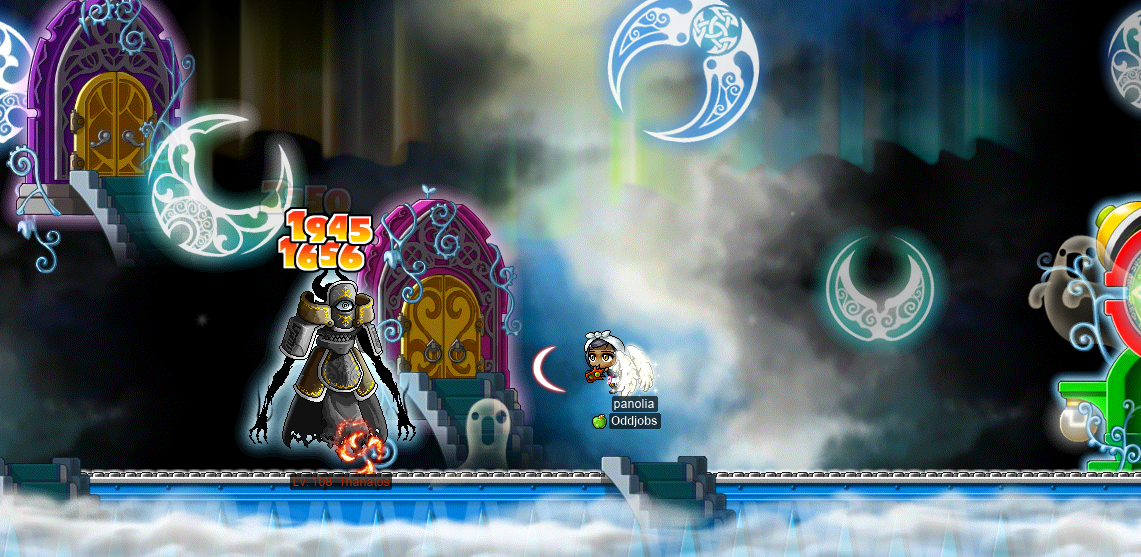
Again, yikes, that is a full 22 levels above me — you can see that its nametag is displayed in crimson as a result. But, what the heck, it’s only got 70k HP, so it looks like panolia’s got a Ludi Medal after all! Mayhaps we shall see panolia & the osslockers face up against Papulatus in the future…… Stay tuned!!
alces
In previous diaries, I’ve talked about my “alces challenge” that I set for my daggermit alces. The basic idea is simple: grind EXP on alces for exactly 60 minutes each day, in order to get her to level 120 and the honourable rank of daggerlord! So, let’s get it!!
To start things off, I decided to just steal some time to get the Capt. Latanica prequests done. I previously mistakenly believed that I had already done them, which resulted in some confusion in a previous diary entry when I did 2× Lat with Taima/Boymoder, following by some HH hunting. So, it was time for alces to kill some Pac Pinkies at GS1…:

…Followed by some Selkie Jrs. & Slimies, at þͤ olde MP3…:

…And finally, some big ol’ Mr. Anchors, at GS6:

That leaves us with… well, you already know what it’s gonna be: more solo SW training at 5–6 F…

Ah, but don’t fret — it wasn’t all lonely sadgrind! Here I am at CDs with INTlaw Lvl1Crook (Level1Crook, xXCrookXx), grinding away:

But, you know, there was also a lot of sadgrinding…
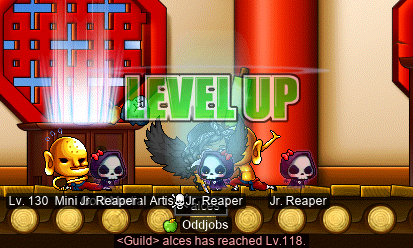
I was, however, blessed to be able to attend CDfest™, which was held at the honorary Oddjobs HQ: channel 4 of CDs!:

In the above image, you can see myself, Lvl1Crook, cowgirl Dakota and her bishop MiIf, the daggerbros inject (inhale, vvvv, eject) the dagger sader & daggerknight (Gumby, Jonathan) the dagger DK, and Gumby.
Indeed, there were so many of us — including, later on, STRginner Taima (Boymoder, Hitodama, Nyanners, Hanyou, Tacgnol, pilk) — that I just assumed that we’d have to split up across two different channels. We did split up into two separate parties, but we kinda… just all stayed in the same channel. So it was pretty messy & crowded! A real CDfest!!:


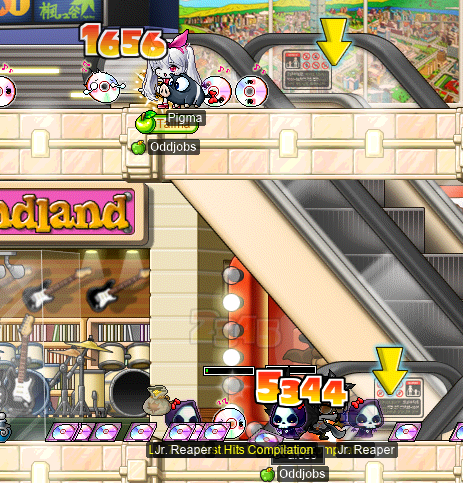
It was a lot of fun!!!
And with that, level 119~!:

Just one more level!!
Whilst I was still a 3rd-jobber, I took the opportunity to do some osslock-friendly Papu runs with osslock DK yeIlo (bak2monke, VAPORWAVE), and chief bandit ULTRAdragon7:

Oh… oupsies.
At this point, I was nearing level 120, so I thought it wise to prepare for buying an HTP. That meant getting Dragon Elixirs and a Certificate of the Dragon Squad! For the Dragon Elixirs, I would need to hunt for Tough Dragon Skins near the peak of the Leafre nest:

These Wyvern guys are pretty tough, but no match for our intrepid daggermit…!
For the CotDS, on the other hand, I would need one of each of the three boss certificates: Zakum, Papulatus, and Pianus. For the Zakum cert, I paid one EoF[1] to a team that was doing a three(!)-Mapler Zak run:
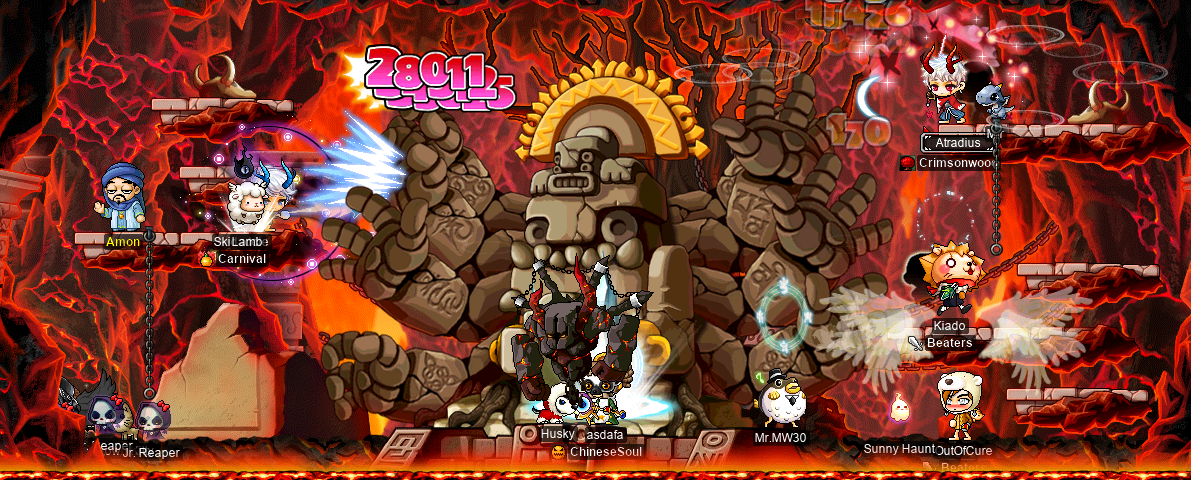
You can see more than three PCs in the party, however, because some of them are multiclienting. In any case, the last bit of this was a bit nervewracking for me, as I had to strike Zak’s third body at least once, in order to produce the certificate. The problem is that I have like… 4.5k MAXHP, and can’t use weapons that aren’t daggers… So I had to be really careful not to get bumped into Zak’s body by a stray summoned monster whilst getting close enough to land a Double Stab. In the end, though, it was fine, and I emerged with a Zak certificate in hand!
As for the other two certificates, I had some invaluable assistance from shadower Harlez (Murhata, VigiI). When it came to fighting Pianus, I initially struggled for the same reason that booping Zak made me nervous: I just don’t have very much HP. Indeed, Pianus (R) one-shot me with basically any of its attacks; that includes touch attacks, but also its giant laser attack that hits across almost the entire map. Because the laser simply one-shots me, it seemed like I had no choice but to have an active spear(wo)man/DK in my party to assist me with HB. I tried getting daggerknight to come help, but by the time that he was ready to come alllll the way over to Aqua Road, I had devised a different solution: standing inside of Pianus (L).
Indeed, Pianus (L) doesn’t hit quite as hard, and Pianus (R)’s laser attack only reaches up to about where Pianus (L)’s lips begin. You can see this in action in the screenshot below:

This is not so bad, at least not when Pianus (L) isn’t weapon-cancelled… In any case, I got my Pianus cert! Huzzah!!
I also had some fun sniping the Bloody Booms with Three Snails…:

If you’re not familiar, Bloody Booms are spawned by Pianus. They are totally immobile, and appear to not have any attacks. But, if you deal enough damage to them to get their HP to ≤50%, they go “boom”. And it hurts. Like, we’re talking “≈10 000 damage” kinda hurts. You can avoid getting hit by the boom if you’re sufficiently far away, but unfortunately for alces, Bloody Booms are boss monsters. Like, they are obviously not “bosses” in the usual sense, but Bloody Booms basically have their “is a boss monster” bit field set to a 1. This means that I can’t SW them. The fact that I can snipe them with Three Snails is pretty humorous, although you shouldn’t take it too seriously; in order to actually get them to boom, I would have to hit them about (10 000∕2)∕40 = 125 times each…
For the Papulatus cert, we headed to the origin of the Ludibrium Clocktower to fight our favourite blue alien guy, Papu:

In order to get the cert, though, I would need to attack the 2nd body. That’s a bit of a problem, as there’s basically no way for me to not get touch-attacked by it in the process, and getting touch-attacked would certainly slay me. Well… unless I had a smokescreen (HB would also have worked)…:

Speaking of HB also working, I got to do an actual full Papu run with yeIlo & ULTRAdragon7 this time!:
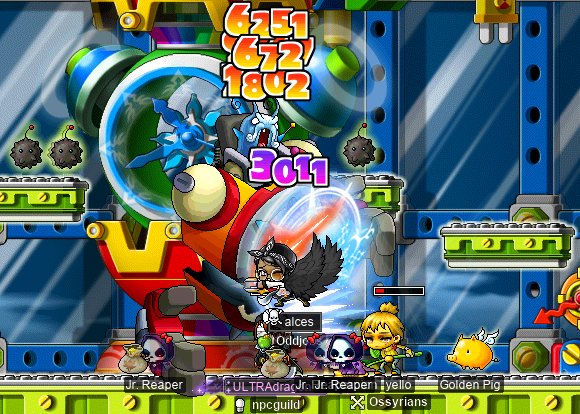
Really fun stuff!
And then… it was time. for being at 99.99% EXP until my ✨level 120 party✨!!!
You can watch a video of alces’s level 120 party here, on the Oddjobs YouTube™ channel!!!!

alces… is a daggerlord now. 🥹 Although I may have some other business to take care of for now, rest assured that alces will hunt many a card, and spend many a 4th-job SP — still on a mission to be the stabbiest nightlord of all time.
Footnotes for “alces”
alces’s Theme
In pt. lxxx of this diary, I talked about the musical theme that I wrote for my I/L archmagelet cervine: cervine’s Theme. cervine’s Theme is certainly not the first musical theme that I’ve written for one of my MapleStory characters: there’s also rusa’s Theme, capreolina’s Theme, & cervid’s Theme. However, it was the first such theme that I accidentally spent a month writing a smol master’s thesis about. As seen above, my daggerlord alces is now… well… a daggerlord!! So, naturally, I needed to write a theme for her as well.
If you plan on reading this section (big if…), then I recommend at least skimming the “cervine’s Theme” section of pt. lxxx; I won’t be explicitly going over some of the concepts that I already did in that piece. Unlike last time, I’m not writing this as I write the piece; instead, I’ve completed the piece in its entirety, and I’m writing about it immediately after the fact. I’m going to try(!) to not make this a month-long endeavour. No guarantees, though…
A doubling (a doubling)
When I first thought of what alces’s Theme might sound like, the first thing that popped out to me was her association with the Double Stab skill. Naturally, as a daggerlord, her primary attack is Double Stab, and perhaps the most distinctive part of it is encapsulated by the first word in the name: double. Thus, the primary concept of the piece: doubling.
I also considered other æsthetic aspects of alces as a character. She’s canonically undead, has kind of a 👻spooky👻 look, she’s a 🌃nightlord🌃, all that shit. Real Hallowe’en-y vibes, you know? In the end, I’m not sure that I managed to fit all that much of the textural theming into the piece. There’s still a decent amount of it in there, but I never managed to work a pipe organ in there! Nothing says “spoopy” like vaguely dissonant pipe organ solos!!
In any case, one way to work in the Double Stab æsthetic is merely to imitate it: two nearly-identical “stabs” (where “stab” here is intended to be interpreted musically), followed by a brief pause, and then potentially followed by another pair of stabs. There’s a lot of musical mileage that you can get out of this kind of imitation if you’re sufficiently clever. Nevertheless, I initially decided against this approach, because I had something slightly different in mind. In the end, I did incorporate this approach to a limited degree in one or two of the parts (viz. the soprano sax and drumkit parts), but we’ll get back to that later.
With the imitative approach, the most obvious thing that comes to mind (at least, for me) is a simple “galloping” rhythmic pattern. I don’t mean gallop in the narrow sense of a heavy metal gallop, but rather, a pattern similar to one of the following:
In drum tablature
|oo--oo--oo--oo--||
1 + 2 + 3 + 4 +
Refer to the drum tablature legend in pt. lxxx.
In drum tablature
|oo-oo-oo-oo-||
1 2 3 4 5 6
Refer to the drum tablature legend in pt. lxxx.
In the above examples, the rhythmic value/duration of the pause between “double-stabs” is not conceptually significant; rather, it mostly serves to change how rapid the stabbing sounds. By contrast, the “slightly different” approach that I had in mind was much more concerned with “doubling” per se. Rather than crafting a rhythm to imitate the surface qualities of a Double Stab, the question that I want to ask is: what happens when you double a rhythm?
Naturally, there are quite a variety of ways in which one can reasonably interpret this question, as it’s intentionally nebulous. One aspect that I want to set in stone right away is that the rhythmic doubling should be diachronic. One way that we can “double” a rhythm is by playing that rhythm, whilst simultaneously playing the same rhythm — or a closely-related one — possibly at an offset, so that they interact to produce something more substantial. This “simultaneous” notion is what I’m going to refer to as synchronic, as contrasted with diachronic. This is an artificial restriction, and I’m imposing it because it fits more closely with the imitative approach, wherein one stab is immediately followed by its double.
The first section (𝑔′)
The simplest diachronic doubling, then, is exactly what you’d naïvely expect: just play the same thing twice, in immediate succession. That’s perfectly fine, but it’s also not very interesting. In particular, repeating this process results in effectively just spamming the same thing over & over, with no discernible structure other than the fact that you’re repeating it exactly 2𝑘 times, for some natural number 𝑘. Much like in pt. lxxx, we can think of a rhythm — or more generally, a melody, wherein the notes can have pitch values — as a finite sequence (equivalently: a string, or a list) in which every element has an associated rhythmic value (a.k.a. duration). Also like in pt. lxxx, we observe that a rhythmic value can be formalised as simply a positive[1] rational number. If 𝐴 is our initial rhythm, 𝑓 is our naïve doubling function, and we denote concatenation by mere juxtaposition, then we can easily see the behaviour of 𝑓 by example:
𝑓(𝐴) = 𝐴𝐴 = 𝐴2.
𝑓2(𝐴) = 𝐴𝐴𝐴𝐴 = 𝐴4.
𝑓3(𝐴) = 𝐴𝐴𝐴𝐴𝐴𝐴𝐴𝐴 = 𝐴8.
𝑓4(𝐴) = 𝐴𝐴𝐴𝐴𝐴𝐴𝐴𝐴𝐴𝐴𝐴𝐴𝐴𝐴𝐴𝐴 = 𝐴16.
⋮
To make things more interesting, then, we consider adding another “doubling function” into the mix. This doubling function, which we’ll call 𝑑,[2] operates differently; rather than concatenating sequences with themselves, this doubling function doubles the rhythmic values of the notes (elements) that make up the sequence. If 𝑎𝑖 is the 𝑖th element of 𝐴 (that is, 𝐴 ≝ ⟨𝑎0, 𝑎1, 𝑎2, ⋯, 𝑎𝑛−1⟩), and 𝑎𝑖 is defined as an ordered pair (𝑟𝑖, 𝑝𝑖) of a rhythmic value 𝑟𝑖 and a pitch 𝑝𝑖, then 𝑑 can be defined like:
𝑑(𝐴) ≝ ⟨(2𝑟0, 𝑝0), (2𝑟1, 𝑝1), (2𝑟2, 𝑝2), ⋯, (2𝑟𝑛−1, 𝑝𝑛−1)⟩.
Well, it’s not so interesting quite yet; 𝑑 basically just halves the tempo of its argument. The interesting part is what we can do by combining 𝑑 (or a function creatively similar to 𝑑, as we’ll see later) with the kind of concatenation-based doubling provided by, for example, 𝑓. This brings us to a more advanced function, which we’ll call 𝑔, that can be defined as follows (let 𝑘 be a natural number):
𝑔(𝐴, 0) ≝ ⟨⟩.
𝑔(𝐴, 𝑘) ≝ 𝐴 𝑑(𝐴) 𝑑2(𝐴) 𝑑3(𝐴) ⋯ 𝑑𝑘−1(𝐴).
If 𝐴 has unit duration, then the result of applying 𝑔 is the concatenation of regions of duration 20, 21, 22, 23, 24, ⋯, 2𝑘−1. The total duration of 𝑔(𝐴, 𝑘), then, is the sum of all natural powers of 2 that are strictly less than 2𝑘. If we express the summands in binary, then instead of “20, 21, 22, 23, 24, ⋯”, we have 12, 102, 1002, 10002, 100002, and so on. The partial sums are then 12, 112, 1112, 11112, 111112, and so on. In decimal, that is 21 − 1, 22 − 1, 23 − 1, 24 − 1, 25 − 1, and so on. This is sequence A000225 in the OEIS, which are sometimes called the Mersenne numbers, although this is more often used to refer to A001348, which are 2𝑘 − 1 where 𝑘 must be prime. So, maybe we can call them “Mersenneoids”, or something dumb like that. In any case, the fact that Marin Mersenne is showing up here is quite the coincidence — or perhaps not-so-coincidence — as Mersenne is known for being an influential early 17th century music theorist.
If 𝑔 gets us successive doublings (“doubling” in the duration sense), then we might wonder what happens if we take this notion of succession a step further. Consider a function 𝑔′, which is defined as follows (again, 𝑘 is some natural number):
𝑔′(𝐴, 𝑘) ≝ 𝑔(𝐴, 0) 𝑔(𝐴, 1) 𝑔(𝐴, 2) ⋯ 𝑔(𝐴, 𝑘).
Now, the durations of the regions, in order, look like:
20, 20, 21, 20, 21, 22, 20, 21, 22, 23, ⋯
If we use round brackets to enclose each application of 𝑔, then the pattern becomes more obvious:
(20), (20, 21), (20, 21, 22), (20, 21, 22, 23), ⋯
By analogy with how we defined 𝑔′, we could define 𝑔″, 𝑔‴, and so on. However, I think that 𝑔′ really hits the sweet spot where things get interesting, without recursing to unnecessary levels of depth.
Like with 𝑔, we naturally want to ask what the total duration of the resulting sequence is. As it turns out, the total duration of 𝑔′(𝐴, 𝑘) is given by the (𝑘+1)th element (zero-indexed) of A000295. The OEIS calls these Eulerian numbers. There is a Wikipedia article on Eulerian numbers, but the OEIS seems to use the term Eulerian triangle for this more general function, which takes two arguments instead of just one. The zero-indexed version[3] of the Eulerian triangle is given by A173018, and the Eulerian numbers that we’re concerned with are the column of this triangle where 𝑘 ≔ 1 (“𝑘” in this context is the second parameter of the Eulerian triangle function; Wikipedia calls it “𝑚”). The terms of A000295 can be easily calculated as A000295(𝑘) = 2𝑘 − 𝑘 − 1. Wikipedia gives a combinatorial definition of the Eulerian triangle, like so:
[T]he Eulerian number 𝐴(𝑛, 𝑚) is the number of permutations of the numbers 1 to 𝑛 in which exactly 𝑚 elements are greater than the previous element (permutations with 𝑚 “ascents”).
In our case, we have 𝑚 ≔ 1, so the total duration of 𝑔′(𝐴, 𝑘) is the number of permutations of {0, 1, 2, ⋯, 𝑘−1, 𝑘} (note the “0”) in which exactly one element is greater than the previous element. Huh. Kinda funky.
The second section (η𝑘)
Anywho, 𝑔′ will serve as the conceptual foundation of the first section of alces’s Theme. However, alces’s Theme has essentially two contrasting sections, and the latter section doesn’t make use of 𝑔′. Instead, the latter section uses a different kind of doubling, which is based on the notion of 𝐴 ↦ 𝐴𝐴′. That is, basically like 𝑓, except that we do the thing slightly differently the second time (𝐴′ instead of 𝐴). This avoids the problem of the naïve function 𝑓, where we end up mindlessly spamming the same thing over & over if we don’t start getting real creative real quick.
There’s just one problem: the mapping 𝐴 ↦ 𝐴𝐴′ isn’t well-defined unless we know what the prime symbol (′) is doing here. So I came up with a very simple function — which we’ll just call 𝑝 — that gives us the “plus one” of a sequence, incrementing the duration of each element by 1:
𝑝(𝐴) ≝ ⟨(𝑟0 + 1, 𝑝0), (𝑟1 + 1, 𝑝1), (𝑟2 + 1, 𝑝2), ⋯, (𝑟𝑛−1 + 1, 𝑝𝑛−1)⟩.
We can use 𝑝 as effectively the “prime symbol” of the mapping 𝐴 ↦ 𝐴𝐴′, and formalise this mapping as a function η:
η(𝐴) ≝ 𝐴 𝑝(𝐴).
All pretty simple, right? For the second section of alces’s Theme, we’ll consider repeated applications of η, e.g. η5(𝐴). If we again assume that 𝐴 has unit duration, and we ignore pitch values, then we can quickly & easily see what the note durations will look like for η𝑘(𝐴) by simply consulting a computer… We’re just gonna use Python for this:
from functools import reduce
def apply_k(k, f, a):
"""Applies the function ``f`` to ``a``, ``k`` times.
In other words, computes ``(f**k)(a)``.
"""
return reduce(lambda a, _: f(a), range(k), a)
def p(a):
return [e + 1 for e in a]
def eta(a):
return a + p(a)
(See: eta.py)
Evaluating apply_k(5, eta, [1]) — which corresponds to η5(𝐴) — gets us the following result:
[1, 2, 2, 3, 2, 3, 3, 4, 2, 3, 3, 4, 3, 4, 4, 5, 2, 3, 3, 4, 3, 4, 4, 5, 3, 4, 4, 5, 4, 5, 5, 6]
Searching this up in the OEIS gets us to A000120, which the OEIS describes as the “number of 1’s in [the] binary expansion of 𝑛”. This is the same as the Hamming weight of the binary representation of 𝑛. This makes sense: as you go through the natural numbers in order, each time that you get to a power of 2, the length[4] of the binary representation[5] increases by 1. Now there’s a “1” in the next most significant position that so far has only ever been an implicit “0”, but you otherwise repeat every binary representation that you’ve seen so far, in order. Because of the new “1”, the Hamming weight of these “repeats” is increased by 1. Rinse & repeat. This pretty clearly corresponds to the definitions of η and eta above.
As expected, the “doubling functions” that we’ve explored here are all closely related to powers of 2, binary numbers, and so on.
Footnotes for “A doubling (a doubling)”
- [↑] In pt. lxxx, we actually allowed rhythmic values to be arbitrary rational numbers, in order to retain some nice algebraic properties. I don’t think that that will be necessary here, however.
- [↑] In pt. lxxx, this function is called 𝐒2.
- [↑] The classic one-indexed version is given by A008292.
- [↑] In the ordinary sense of a string’s length, not in the sense of Hamming distance.
- [↑] That is, the canonical representation where there are no leading zeroes.
First section
Main part
For the first section of alces’s Theme, let’s first look at its main part:
In ABC notation
%abc-2.2
X:1
T:“alces’s Theme”: main part of first section
C:deer
%%score { 1 | 2 }
M:1/16
L:1/16
Q:1/4=96
I:linebreak $
V:1 treble
V:2 bass
K:E
[V:1] z |[M:3/16] z3 |[M:7/16] z7 |
[V:2] G,, |[M:3/16] G,, (G,,E,) |[M:7/16] G,, (G,,E,) (G,,E,^A,D) |
[V:1] [M:15/16] z z2 z3 E z3 EBAcd |
[V:2] [M:15/16] F,, (F,,C,) F,,C,B,2 F,,C,B,2 z4 |
[V:1] [M:31/16] z z2 z4 z4 DGce z4 DG^Bfdegfa^be'g' ||
[V:2] [M:31/16] A,, (A,,D,) (A,,D,A,C) A,,D,A,C z4 A,,D,A,C z12 ||
(ABC notation doesn’t allow for slurs across voices/staves.)
This part is written for harp, although it’s also later doubled by a celesta.
Rhythm
We can already see evidence of the use of 𝑔′ here just by glancing at the time signatures. We’re using the 16th note as the basic unit duration here, so the denominator of all of the signatures is 16. The numerators, however, follow the sequence ⟨1, 3, 7, 15, 31⟩; that is, ⟨21 − 1, 22 − 1, 23 − 1, 24 − 1, 25 − 1⟩. Within each bar, I’ve grouped (and also slurred) the notes to reflect each individual region; these “regions” were encoded as what I called “notes” in the formalisation from the “A doubling (a doubling)” section above. Instead of letting each element just be a single note, each element is filled out with a 16th-note arpeggiation of what is effectively an underlying chord for that region. So in actuality, the so-called “pitch values” from the above formalisation were a lie — we really just needed the rhythm! Sort of!!
Harmony
The arpeggiations always start at the bottom, and go up from there. Thus, towards the beginning of each bar, not very many notes of the chord are elaborated; then, as the bar continues, exponentially more notes of the underlying chord are revealed. We can easily spell out the chords by just looking at the score above (I’m omitting octave numbers here):
- mm. 1–3: ⟨G♯, E, A♯, D♯⟩.
- m. 4: ⟨F♯, C♯, B, E, B, A, C♯, D♯⟩.
- m. 5, bb. 1–15: ⟨A, D♯, A, C♯, D♯, G♯, C♯, E⟩.
- m. 5, bb. 16–31: ⟨A, D♯, A, C♯, D♯, G♯, B♯, F♯, D♯, E, G♯, F♯, A, B♯, E, G♯⟩.
Note that I’m putting each sequence in the order that it’s played in, which is not quite in ascending order of pitch. I take some liberties with the directionalities of the “arpeggiations” here, to make them more melodic…
It’s easier to see what’s going on here if we rewrite these sequences in integer notation, letting the origin (the 0) for each sequence be the root of that chord (note that this implies that the various sequences will generally have differing origins):
- mm. 1–3: ⟨4, 0, 6, 11⟩.
- m. 4: ⟨0, 7, 5, 10, 5, 3, 7, 9⟩.
- m. 5, bb. 1–15: ⟨0, 6, 0, 4, 6, 11, 4, 7⟩.
- m. 5, bb. 16–31: ⟨1, 7, 1, 5, 7, 0, 4, 10, 7, 8, 0, 10, 1, 4, 8, 0⟩.
Naturally, the way that the origins are chosen here already assumes some particular tonal analysis. That particular analysis looks something like (refer to the “Roman numeral analysis legend” in pt. lxxx):
- mm. 1–3: I∆7♯1165.
- m. 4: ii13.
- m. 5, bb. 1–15: IV∆7♯11.
- m. 5, bb. 16–31: III𝖺𝗅𝗍743(×IV∆7♯11).
Spiritually, this is I∆7 – ii13 – IV∆7 – V𝖺𝗅𝗍7⧸vi, but there are some complications. Our humble tonic “I∆7” chord is made a tad bit 🌶️spicy🌶️ with the non-diatonic sharpened eleventh factor[1], in addition to not being in root position (in particular, it’s in first inversion). More to the point, the phrasing here makes measure 5 a bit confused: the final arpeggiation starts its first 4 notes in the same way that the previous parts of the measure already did, but then decides to do… something else. That’s why I’ve written the last item in the above list as kinda-sorta a polychord, but parenthesised. Depending on how seriously you take the phrasing, and depending on whether or not you’re okay with having a perfect (rather than augmented) eleventh factor (the C♯) in a so-called altered dominant chord[2], there may or may not actually be a polychord here. Speaking of dominants, this final chord is actually a secondary dominant chord borrowed from the relative minor (C♯ minor). I only wrote it as “III𝖺𝗅𝗍7” to avoid possible confusion with the tentative polychord notation — it’s better written as V𝖺𝗅𝗍7⧸vi.
Texture
As already mentioned above, I took some liberties with what would otherwise be a straightforward textural decision here: to make every arpeggiation region strictly monotonically ascending. This allowed me to add some flavouring that causes the arpreggiations (or rather, part of them) to sound like proper melodies. This takes a texture that would otherwise be described as somewhere between monophony (as it is, on a technical level at least, strictly “monophonic” insofar as there is only one part, which is only playing at most one note simultaneously…) and “just chords/accompaniment”, and lends it a whiff of proper homophony.
The structure of these arpeggiations is also tied to the evocation of alces’s æsthetic as a character: there’s a certain amount of gracefulness & agility captured by them — perfect for a daggerlord!
Furthermore, the choice of harp is somewhat significant. For one, I needed an instrument that made sense with the whole “exponentially-elaborated giant arpeggios” thing, and modern pedal harps generally have a very large playing range, in addition to obviously lending themselves to this kind of arpeggio playing. But also, I think(?) that the harp is frequently used in Western classical music to evoke heaven, and heavenly entities like angels. alces is undead, so maybe this is actually ass-backwards. Nevertheless, she does wear giant wings (often used in Western depictions of angels), and being undead does mean that she, you know, used to be dead. It’s up to you, the listener, to decide whether she comes from heaven or from hell……
Embellishing the main part
Starting at measure 6, five new parts are added to the piece. Three of these new parts are texturally important, but otherwise not all that interesting: the bass guitar part, the double bass part, and the contrabassoon part. We also have the celesta part, which is there to merely to double the harp, purely for timbral reasons. Then, we have the drumkit part, which is the most interesting new part at this point.
Basses
As I said, the bass parts are texturally important but otherwise uninteresting: they selectively double the harp part, only on the first note of each arpeggiation region. This has essentially three effects:
- Harmonically, emphasising the pitch class of the bass note of the chord that underlies that arpeggiation region. The bass note of a chord is a very important component of that chord — indeed, it is the only note in the chord that truly decides what inversion[3] the chord is in.
- Rhythmically, further outlining & emphasising the fundamental rhythmic structure that this passage is built on, which is of course based on 𝑔′.
- Timbrally, serving a similar role to the celesta part insofar as it fleshes out the sonic landscape of the harp part.
Drumkit
The use of drumkit is a common theme connecting all of the themes that I’ve written. I’m predisposed to it, as it’s kinda my favourite instrument. Plus, it’s naturally very versatile, so it’s easy to use in basically any piece that might even vaguely call for one or more percussion parts.
There’s kinda a lot going on in this drumkit part, but there’s one or two things that I want to point out for being particularly important details.
One simple detail is that I make sure to use the kick drum effectively. There’s a kick drum hit at the beginning of each arpeggiation region, in unison with all three bass parts; the function here is perhaps obvious. Furthermore, I use the kick drum at some other times as well, but I try to be careful not to confuse or muddy the waters by being constantly out of unison with the bass parts; instead, the other kick drum hits are strategically placed.
Another detail is the intentional use of some Double Stab imitation, particularly in the last bar of the part. For reference, here’s that last bar:[4]
In drum tablature
H|o---------xx----------xx-x------------x--xx---x--x--x--x------||
R|--b-----b-----b-----b-----b-----b-----b-----b-----b-----b-----||
S|----gg------o----oo-------------o--oo-------o--oo-------o-ooo-||
B|o-o---o-------o--------------oo-------------------o--oo-------||
1 1 2 1 2 3 4 1 2 3 4 5 6 7 8 1 2 3 4 5 6 7 8 9 0 1 2 3 4 5 6
1 1 1 1 1 1 1
Refer to the drum tablature legend in pt. lxxx.
We can see — and especially, hear — a number of “double-stabs” here; in particular (note that you might have an easier time looking at the drum tablature rather than the standard notation here):
- The closed hi-hat double-stab on beat 6.
- The snare double-stab starting mid-beat 9 and ending on beat 10.
- The pair of double-stabs between the closed hi-hat and the ride bell starting on beat 12 and ending on beat 14.
- The kick drum double-stab starting mid-beat 15 and ending on beat 16.
- The snare double-stab starting mid-beat 18 and ending on beat 19.
- The closed hit-hat double-stab starting mid-beat 21 and ending on beat 22.
- The snare double-stab starting mid-beat 24 and ending on beat 25.
- The kick drum double-stab starting mid-beat 27 and ending on beat 28.
The effect is, I think, aurally pretty evident: as the bar progresses, you can hear a kind of “cascade” as these “double-stabs” travel across the various drums. The fact that so many of them start mid-beat (where “beat” here is actually just a 16th note’s duration) also really helps to make the effect stand out.
Oh, and another thing worth pointing out is the use of the ride. It’s maybe not conceptually significant, but I like how it turned out. The ride bell pattern starts on the second beat of the measure, making it sound like an ordinary cross-rhythm kinda deal. But then, it proceeds exactly in dotted eighth notes, which just so happens to line up exactly with the time signature: the first beat was skipped, meaning that there’s now 31 − 1 = 30 beats remaining, and each dotted eighth note takes up 3 beats, which divides evenly into 30. I would not, however, classify this as a cross-rhythm, as there’s no real “prevailing metre” to be “crossed”.
The soprano saxophone part
For the final bit of the first section, we just introduce a soprano saxophone melody on top of it all. This melody adds novel material to the piece, so let’s take a look at the whole thing:
In ABC notation
%abc-2.2
X:2
T:alces’s Theme: soprano saxophone part
C:deer
M:1/16
L:1/16
Q:1/4=96
I:linebreak $
V:1 treble instrument=_B
K:F#
V:1
|: (g |[M:3/16] a) z (d |[M:7/16] e) z (c/d/) z (d/e/) z (^B/d/) |
[M:15/16] z{/f} (ge cA)(af{/d} ed)(c^B)ddff |1
[M:31/16] e z (B/d/) .e2(g/a/) z (f/g/) z e(d/^B/) z .e2(F A=B^^c)e z
(a/g/e/f/g/a/).e2(d/f/a/g/f/d/A/c/f/a/)b :|2
[M:31/16] e z (B/d/).e2(g/a/) z (f/g/) z e(d/^B/) z .e2(F A=B^^c)e z
(a/g/e/f/g/a/).e2(d/f/a/g/f/d/A/e/c/B/A/B/) ||
[M:7/16] .c2 z2 z3 ||
So, I think we can immediately detect where the “Double Stab imitations” are coming from here — there’s a lot of fast little two-note squawks going on. I think that this part is fairly idiomatic for soprano saxophone (although I do say that as someone who has never actually played a saxophone ROFL), staying within its comfortable range, and playing something that I’d actually expect to hear from a sax player. The slight issue is, uh, the key signature — that’s a lot of sharps!! Keep in mind that the soprano sax is a transposing instrument that sounds a major second lower than written (i.e. it’s in B♭), which is why the key signature has two more sharps here than it does for all of the other parts.
Even the parts of this melody that aren’t obviously double-squawks (lol) I tried to organise relatively rigidly in mostly even-numbered groups. This is not really anything special in general, as this is frequently the case in Western music anyways, but I had to do it intentionally, in order to avoid the likely very different thing that I’d get if I wrote the melody more freely.
There’s kind of a weird A♯ (speaking in terms of concert pitch) in the first half of the 31⁄16 measure, which should probably be an A♮. Interpreted as literally an A♯, this is a cross-relation with the A♮ in the chord below. This is still true even if we interpret it as a B♭, because the chord also features a single G♯ (thus producing a Forte 3-1). However, neither the A♮ nor the G♯ actually sound simultaneously with this A♯/B♭, plus A♯ features prominently elsewhere, and — perhaps most importantly — it’s just a single 32nd note, so it goes by real quick-like. I would consider this “basically a mistake”, but I’m not going to fix it because:
- I already posted it on bandcamp™, and used it in the video on YouTube™, so I would really have to bother myself to just fix this one 32nd note LMAO. Too ceebs for that shit.
- It weirdly still sounds good?? Like, it has to be partly because the cross-relation is not actually evinced in any simultaneity (as I noted above), but the phrase actually sounds more natural ending on a dissonance like that — even if the “dissonance” is actually a generally undesirable cross-relation. Perhaps the key word here is “generally”; there are (admittedly rare) cases where cross-relations have been done ✨very classically✨ in a controlled manner.
So, we’re leaving it in there for the spice. The spicy-dicey excitement. A♮ just isn’t spicy enough for me!!
Let’s take a look at some other note choices here in more detail…
In the 15⁄16 measure, we have two phrases that are pretty obviously outlining chords:
- This measure starts by simply (well, other than the grace note) descending in thirds: F♯, D♯, B, G♯. This is a G♯ minor seventh chord in root position, which would make it the diatonic iii7. It sounds fine over what I’ve analysed here as an F♯ minor thirteenth chord, the ii13. I don’t think that there’s much to it (basically any diatonic pitch will sound at least “fine” over ii13), but the nice thing about having what is effectively a descending arpeggio is that it contrasts nicely with what’s happening in the harp/celesta parts — namely, ascending arpeggios.
- The final five notes of this measure also outline a chord (this time, ascending) like so: A♯, C♯, E. This is an A♯ diminished triad (a.k.a. A♯°), which would be the ♯iv° — perhaps better written enharmonically as ♭v° — of the key. Now we’re gettin’ functional with it! The ♭v° generally has a pre-dominant function, as it contains a leading tone to the root of the dominant chord (i.e. the V), as well as a leading tone to the third factor of the dominant chord. It’s not great at having a dominant function (although it certainly could suffice — pre-dominant chords are frequently used to resolve to tonic chords in popular music) because that leading tone to the third factor of V is, well, the tonic of the key (viz. E♮, in this case).
The harmonic content of the harp part in the 31⁄16 measure is already discussed in some detail above. In that discussion, we ran into the bizarre world of whatever the hell is going on with that final super-large arpeggio. As a result, it’s maybe worth looking at the last three phrases of the soprano sax part note-for-note, as these three phrases are the ones that coincide with the super-large arpeggio. For simplicity, we’ll only look at the first ending, ignoring the second ending.
-
The third-to-last phrase proceeds thus: E, G♯, A, B♯, D♯. That jump from A to B♯ is a spicy augmented second, giving this a little funky attitude. All five of these pitch-classes are also found in the harp part below, so there’s no new harmonic material here really. Looking at these five pitch-classes relative to the “V𝖺𝗅𝗍7⧸vi” underneath gets us: ♭13, 1, ♭9, 3, 5.
But wait — this phrase actually occurs before we get to the V𝖺𝗅𝗍7⧸vi bit, so we’re still nominally in IV∆7♯11 territory. That means that this phrase is actually anticipating the V𝖺𝗅𝗍7⧸vi bit; relative to the IV∆7, these pitch-classes would be: 5, 7, 1, ♯9, ♯11. That ♯9 is real sneaky, as a IV∆7♯11 would normally imply an ordinary major ninth, not an augmented one. Nevertheless, because the eleventh of the chord is augmented, this doesn’t produce (implicitly or otherwise) a Forte 3-1, or anything like that. Instead, the implication is more like A Lydian ♯2, which is the sixth mode of the C♯ harmonic minor scale. This is basically par for the course, as C♯ minor is indeed the relative minor of the key that we’re in (E major). This undoubtedly helps to glue together this monster arpeggio in the harp part.
-
The penultimate phrase proceeds thus: G♯, F♯, D♯, E, F♯, G♯, D♯. No new harmonic material, as all of these pitch-classes are contained in the harp part below.
-
The last phrase proceeds thus: C♯, E, G♯, F♯, E, C♯, G♯, B♯, E, G♯, A. The C♯ here does appear in the harp part, but only in the lower half, viz. the IV∆7♯11 bit. The fact that it appears here twice(!) in the sax part, so late in the measure, reinforces that this is indeed a C♯ (the 11 of the V𝖺𝗅𝗍7⧸vi) and not a C𝄪/D♮ (which would be the ♯11/♭5 of the V𝖺𝗅𝗍7⧸vi) as you might otherwise suspect.
Also worth noting is that this last phrase manages to outline two chords in quite a short timespan. The first seven notes outline a C♯ minor triad in second inversion (with a single lone F♯ in there for melodic sensibility…), and the 7th through 10th notes outline an E augmented triad (a.k.a. E+, a.k.a. B♯+, a.k.a. G♯+). Because we’re in the key of E major, that would be the I+ chord. For a major key, this is actually not unusual — traditionally, augmented triads in major keys tend to be the I+, the IV+, or the V+ (this last one effectively being an altered dominant). As you’d expect, though, an I+ chord tends to serve a pre-dominant function, as it shares two important common tones (the root and the third) with the I, thus making it apparently not a very good dominant. Because this chord shows up at essentially the end of the entire damn part, this is maybe disappointing, as we’re just preparing to go back to I — or rather, to I∆7♯11. However, that’s where the 11th and final note in this phrase comes in to save the day: the A♮. A♮ is a leading tone for G♯, which is the third factor of both I+ and — importantly — I. Thus, it serves to fill out the end of this melodic line whilst simultaneously satisfying the same harmonic function as the seventh factor of a hypothetical V7.
Footnotes for “First section”
-
[↑] This tone is morally “borrowed from the parallel Lydian”. In jazz, this is so standard as to not warrant any further explanation beyond “Lydian is just the normal scale that you play over major seventh chords…”. (See also.)
-
[↑] A perfect eleventh factor in an altered dominant chord is “weird” (or even theoretically incoherent) for two reasons that are actually the same reason:
- In combination with two very common chord factors of altered dominants, namely the ♭5/♯11 and the 3, it produces a cross-relation (Forte 3-1).
- It’s typically the same pitch class that you’re resolving to (or pretending that you’re gonna resolve to), which kinda partly defeats the point. The point is to generally avoid the chord that you’re resolving to, instead preferring leading-tones that anticipate it.
-
[↑] Counting root position as effectively “0th inversion”.
-
[↑] Like in pt. lxxx, all notational conventions for drumkit used throughout this document are adapted from Audio Graffiti’s Guide to Drum & Percussion Notation (2004) (archived), which is based on Norman Weinberg’s Guide to Standardized Drumset Notation (2002; 1998). The only deviation that I use is denoting open hi-hat hits by circling the notehead, rather than having an open circle just above the notehead. This is mostly just to make it easier to work with in MuseScore.
Second section
Let’s do the same thing that we did for the first section — namely, start out by looking at the harp part…
The harp part
In ABC notation
%abc-2.2
X:3
T:alces’s Theme: harp part, second section
C:deer
M:7/16
L:1/16
Q:1/4=96
I:linebreak $
V:1 treble
K:E
V:1
(B,F) (B,F) (=CE=c) |[M:8/16] (B,F) (=CE=c) (CEc) |
[M:12/16] (!courtesy!CGBe) (B,F) (=CE=c) (CEc) |
[M:7/16] (!courtesy!CGBe) (=CE=c) |[M:2/4] (!courtesy!CGBe) (CGBe) |
[M:5/16] (=DAfgc') |[M:8/16] (B,F) (=CE=c) (CEc) |
[M:7/16] (!courtesy!CGBe) (=CE=c) |
[M:16/16] (!courtesy!CGBe) (CGBe) (=DAfgc') (=CE=c) |
[M:2/4] (!courtesy!CGBe) (CGBe) |[M:9/16] (=DAfgc') (CGBe) |
[M:16/16] (=DAfgc') (DAfgc') (^DAcfad') |]
At first glance, I admit that the time signatures look kinda like random nonsense. So, let’s talk about the rhythm here…
Rhythm
Just like the first section was based on 𝑔′, I promised that this second (and final) section would be based on η𝑘. So, remember when we used a bit of Python code to calculate applications of η𝑘?
>>> apply_k(5, eta, [1])
[1, 2, 2, 3, 2, 3, 3, 4, 2, 3, 3, 4, 3, 4, 4, 5, 2, 3, 3, 4, 3, 4, 4, 5, 3, 4, 4, 5, 4, 5, 5, 6]
apply_k(5, eta, [1]) corresponds to η5⟨1⟩ — again, ignoring pitch values and all that. Because of how η is defined, it’s obvious that η𝑘(𝐴) is a prefix of η𝑘+1(𝐴) for any given value of 𝐴 — and thus, more generally, η𝑘(𝐴) is a prefix of η𝑗(𝐴) any time that 𝑘 ≤ 𝑗. Basically, every time that we increase 𝑘, we get the same thing… but more. More things at the end. Taking this to its logical conclusion, we can produce the full sequence by “merely” evaluating η∞(𝐴), putting aside any care that we might need to take to make such an expression rigourously well-defined…
Doing this for 𝐴 ≔ ⟨0⟩, naturally, gets you the infinite sequence that is named A000120 by the OEIS. We’re starting with 𝐴 ≔ ⟨1⟩ because a region of zero duration isn’t useful in this context, but the result is morally the same, even if the sequence isn’t element-for-element identical; we still have the same fractal structure. The real problem is that η∞(𝐴) is infinite; we can choose absolutely any natural number (no matter how large) to be the value of 𝑘 when we evaluate η𝑘(𝐴), and I ain’t got that kinda time. I don’t just go and sit down for a music concert that lasts for an eternity; what if I need to get up for a bathroom break?
Thankfully, there’s a solution: just stop at some point. I know, I know, no one likes a quitter — but also, no one likes waiting for an infinitely long amount of time for a song to end. Them’s the breaks. Unfortunately, that means that we have to actually make a choice. Disgusting, I know. Specifically, we have to choose when to start, and when to end. The choice is ultimately arbitrary, and here’s what I decided on: use the entirety of η5⟨1⟩, except for the initial lone “1”.[1] I use 𝐴 ≔ ⟨1⟩ because 1 is the smallest meaningful duration, and because it is the unit, and all that, so it makes for a good seed value. Then I kinda arbitrarily decided that I didn’t want regions that were as short as just 1, because that wouldn’t be enough time to outline a chord if I’m arpeggiating them (we’ll get back to that later); with two notes, for example, I can outline the root and the third to effectively imply a triad, or the root and the fifth to get a power chord, or what have you.
Basically, I wanted a vaguely similar texture to the first section. We still have the harp (and the celesta doubling it) cranking out 16th-note arpeggios, but the underlying structure is quite changed now. Plus, a bunch of other stuff is also changed — but we’ll get back to that later, as well…
That brings us to the mysterious time signatures: why do they look so random? Well, the simple fact is that applying η𝑘 gets you a fractal structure, as mentioned in passing above. It’s worth briefly explaining what this mysterious “fractal” word is supposed to mean, because it’s a bit mysterious even to professional mathematicians. I think that Wikipedia does a pretty good job of explaining it as a gestalt of three distinct-but-related factors, which we can summarise like so:
- A fractal exhibits self-similarity, meaning that you can see the same basic shape even if you zoom in or out to different levels of detail. A line is trivially self-similar, because no matter how far you zoom in or out, it still looks like a line. A more interesting example is the Koch snowflake /kɔx/.
- A fractal’s structure is more or less evident even at arbitrarily small scales; even if you zoom in as far as you can muster, you can still see detail. A line may be self-similar, but fails this criterion because you don’t see any more detail by zooming in. A Koch snowflake, on the other hand, may look identical when zooming in by a factor of three, but you’re seeing a new, smaller, more “in-detail” version when you do this — as is evident by zooming in smoothly. Almost all shapes that we’re familiar with from geometry easily fail this criterion, because they look locally “flat” if you zoom in sufficiently far; this is closely related to tangent lines and differentiability.
- Fractals are often recursive in nature simply because there’s no other way to describe and/or define them. The Koch snowflake, of course, is defined recursively. A less obvious example is the coastline paradox, which is apparently not “defined” recursively; the coastline (of whatever landmass you have in mind) is just like that, because… you know, the Earth and shit. Nevertheless, we can’t describe what’s going on in this “paradox” with simple geometry; instead, we have to say something like: “the coastline looks rough & jagged, and as you zoom in to any one of those jags, that jag itself looks just as rough & jagged as what you had before”. That’s recursion!
A000120, and more generally, η∞(𝐴) for any “seed value” 𝐴, satisfies all three of the above criteria:
-
It’s self-similar, because at any scale, you can evidently see the structure of “a string of stuff, and then the same string of stuff but incremented by 1”. It’s difficult to “see” the structure by scrutinising a list of numbers, so let’s look at a pin plot[2] instead:
If the self-similarity isn’t already obvious from the above plot, let’s look at the same plot, but with the maximum value of 𝑖 increased by a factor of 4, effectively zooming out by a factor of 4:
Hmm… Looks the same to me!
-
It’s perhaps less obvious that η∞(𝐴) satisfies the “evident detail, even at arbitrarily small scales” criterion. After all, it seems like we can’t really take it to “arbitrarily small” scales; at some point, we’re at the scale of just a single number! Surely, the detail/structure can’t possibly be evident from just one number! Nevertheless, because η∞(𝐴) is an infinite sequence, there’s a sense in which any finite substring of it — no matter how large! — is already an “arbitrarily small scale”. Keep in mind that we can have infinite substrings of η∞(𝐴) that are nevertheless strict[3]; for example, we could take the substring at all indices 𝑖 such that 𝑖 ≥ 2⇈6.
Another way of saying this is: having the detail/structure be evident at arbitrarily large scales gives us the same thing that we wanted from the “arbitrarily small” formulation, making them “equivalent” in the relevant sense. In particular, anything that satisfies one (or both) of the “arbitrarily small” or “arbitrarily large” criteria satisfies this criterion.
-
This sequence is obviously defined recursively, as expounded in the “The second section (η𝑘)” section above.
What does all of this fractal stuff have to do with the mysterious time signatures? Well, because the rhythm of this part is derived directly from a zoomed-in view of a true fractal, there are only really three ways that we could notate the part — none of which are obviously The Right Way™ to do it:
- Give each element of the fractal sequence its own measure, and thus its own time signature.
- Group the elements of the fractal sequence into “phrases”, and then give each phrase its own measure, and thus its own time signature.
- Give up on the pathetic “barlines” and “time signatures” of mere mortals, instead notating the whole thing as a single giant continuous “measure” with no particular time signature associated with it.
I seriously considered the first option, but decided that it was too fine-grained to facilitate reading & writing. Of course, it has the distinct advantage of making the fractal structure as visually evident as possible. The last option is nice insofar as it’s the most “true” to what’s actually going on, in some sense; time signatures are just not made for this kind of thing! Nevertheless, it’s… well… less than readable, and also I’m too ceebs to figure out how to do it with MuseScore (although I’m sure there’s a way…).
That leaves us with the second option. Note that none of these options result in any of the elements of the η∞⟨1⟩ sequence getting split across barlines; that would be a huge no-no. As a result, because of the rough fractal nature of the sequence, splitting them arbitrarily into phrases tends to get you this random-looking new-time-signature-for-every-measure vibe that you can see in the score above. Of course, the natural question is: how did I decide where to delineate “phrases”? But we’ll get back to that later, when discussing the bass part.
It’s also worth noting that the exact spellings, if you will, of the time signatures are chosen carefully to be “correct”, in some sense. For example, the second measure is in 8⁄16, which has the same extent[4] as 2⁄4. Not only is 2⁄4 an actually commonly-used time signature, unlike 8⁄16, but we see measures of 2⁄4 appearing later on in the part! What gives? Well, the answer is simple: the denominator of each time signature is chosen as the smallest possible denominator such that no element of the η∞⟨1⟩ sequence starts mid-beat. Also, we impose the more obvious constraint that the numerator and denominator must both be positive integers; for example, we could — if it weren’t for this constraint — express the time signature of the first measure as *“3.5⧸8”, without any elements of the sequence starting mid-beat. The time signature of the second measure could equally well be spelled as “(2+3+3)⧸16”. Also, consider the similar — but much more common — situation of 3⁄4 vs. 6⁄8. These two time signatures — both of which are typical & idiomatic — have the same extent as well, but they imply different pulses and different beat groupings.
Harmony
Because the basic texture of the harp part is the same as in the first section — namely, a bunch of ascending 16th-note arpeggios — we naturally want to ask how the underlying chords of these arpeggios are structured. The basic idea is simple: every time that an element of the sequence increases by 1, we raise the root of its corresponding chord by a semitone. I wanted to have this chord progression wrap around back to the tonic (because that’s how the piece starts, and also… you know… it’s the tonic), so I took a look at the substring of η∞⟨1⟩ that I’m working with:
⟨2, 2, 3, 2, 3, 3, 4, 2, 3, 3, 4, 3, 4, 4, 5, 2, 3, 3, 4, 3, 4, 4, 5, 3, 4, 4, 5, 4, 5, 5, 6⟩.
As you can see, the largest element is 6, there’s only one 6, and that 6 is at the very end. So, if we just make D♯ the root of the chord that corresponds to this 6, then starting the piece over from the beginning immediately after this second section ends will give us a root movement of D♯ → E. That’s exactly the movement upwards by 1 semitone that we want! We can then work backwards from there to determine the roots of the chords that correspond to the other elements:
- ⟨⋯, 6, ⋯⟩ ↦ ⟨⋯, (6, D♯), ⋯⟩.
- ⟨⋯, 5, ⋯⟩ ↦ ⟨⋯, (5, D♮), ⋯⟩.
- ⟨⋯, 4, ⋯⟩ ↦ ⟨⋯, (4, C♯), ⋯⟩.
- ⟨⋯, 3, ⋯⟩ ↦ ⟨⋯, (3, C♮), ⋯⟩.
- ⟨⋯, 2, ⋯⟩ ↦ ⟨⋯, (2, B♮), ⋯⟩.
Of course, this only gives us the root of each chord — not the actual full chords. In order to start narrowing things down, we can immediately impose the straightforward constraint that if two elements in the above sequence are equal (e.g. 3 = 3), then they should also have completely identical underlying chords. Sounds fair to me, but we still aren’t there yet.
We can allow the key of the piece (viz. E major) to do a significant amount of the work here. Because we know what key we’re in, and we know the root of a given chord, which other chord factors tonally make sense for that chord are narrowed down significantly. With that in mind, let’s take a look at the actual notes that I did in fact choose (note that the pitch-classes are given in the sequence that they’re actually played in):
| elem | pitch-classes | Roman № | typical function |
|---|---|---|---|
| 2 | ⟨B♮, F♯⟩ | V5 | dominant |
| 3 | ⟨C♮, E♮, C♮⟩ | ♭II(+)⧸V | pre-dominant |
| ♭VI | pre-dominant (parallel minor) | ||
| 4 | ⟨C♯, G♯, B♮, E♮⟩ | vi7 | tonic (relative minor) |
| pre-dominant | |||
| 5 | ⟨D♮, A♮, F♯, G♯, C♯⟩ | ♭VII∆7♯11 | pre-dominant |
| IV∆7♯11⧸IV | pre-(pre-)dominant | ||
| 6 | ⟨D♯, A♮, C♯, F♯, A♮, D♯⟩ | vii𝆩7 | dominant |
The chord on B is very simple, as we only have two notes to work with, so I chose the fifth factor to be the second note. Thus, we are left with just a power chord — but the implication is, naturally, a major triad (the V of the key).
The chord on C♮ is actually similarly bare, as I chose to make two of the three notes C. Thus, we only have the root and the third factor. This arguably leaves it even more ambiguous than the B chord, as the B chord is clearly implied to be a major triad, whereas we fail to specifically imply a major triad (implied G♮, which is not in the key of E major) or an augmented one (implied G♯, which is diatonic to the key). That’s why there’s a “(+)” in my preferred analysis of ♭II(+)⧸V. Analysing it as ♭II(+)⧸V makes it straightforwardly the secondary dominant V⧸V (the most common kind of secondary dominant chord, in my experience), but tritone substituted. Depending on which chord follows it, you might also analyse it as ♭VI, which still has a pre-dominant function, but is borrowed from the parallel minor. Indeed, this is probably the better analysis in general, as the ♭II(+)⧸V analysis only truly makes sense if it resolves to the V, or to some other clearly dominant chord.
The chord on C♯ is quite self-explanatory, as it is just the entirely diatonic vi7 of the key. I have its function written as “tonic”, because it is the tonic of the relative minor, and it contains all three factors of the I triad. However, it can be (and is frequently) used as a pre-dominant, due to sharing all but one of its factors with the IV chord. Thus, I’ve listed it as a pre-dominant as well, which is probably more fitting here anyways.
The chord on D♮ can be analysed simply as a ♭VII∆7♯11, which functions basically like ii, as it contains all three notes of the ii triad. This makes it pre-dominant. It can also be analysed as a secondary chord: IV∆7♯11⧸IV. This secondary chord might look a little weird, but the idea is that it’s basically the amen cadence version of V⧸V (the latter being the ordinary authentic cadence version). The amen cadence is so called due to its idiomatic usage in hymns, but it also occurs in the 12-bar blues and related blues progressions, and of course in gospel music and its derivates, thus making it idiomatic in derivative musical forms — particularly popular music and, to a lesser extent, jazz. Nevertheless, although it frequently makes sense to analyse ♭VII∆7♯11 this way, I don’t think that it’s actually appropriate here — I’ve only included it for completeness.
And finally, the chord on D♯ is a straightforward diatonic half-diminished seventh chord: vii𝆩7. This seventh chord, as well as its corresponding triad (i.e. getting rid of the C♯), is easily used as a dominant due to sharing three of its factors with the V7. It’s probably more commonly used as a pre-dominant, but that’s only because it’s the ii𝆩7 in a minor key. Because we’re in a major key, and because I’m actually explicitly using it as a dominant, I think it’s better to just write its function as simply “dominant”.
Texture
Because the texture of the harp part in this second section is intentionally crafted to be similar to the texture of the harp part in the first section, there’s not much new to say here. Nevertheless, there are two notable differences in just the harp part alone:
- Whereas before I took some liberties with the arpeggios to make them somewhat more melodic and not necessarily monotonic, we now have arpeggiation regions that are all strictly monotonically ascending, and are clearly just chords.
- Whereas before we had arpeggios that started out very short and got exponentially large, culminating in a giant 16-note arpeggio, we now have arpeggiation regions that are all roughly the same duration. Indeed, their durations tend to increase logarithmically — that’s the opposite of exponential!
This second point is particularly crucial to the overall structure of the piece and how it presents itself to the listener. Insofar as the logarithmically-increasing arpeggios in the second section are dual[5] to the exponentially-increasing arpeggios in the first section, the two sections contrast “perfectly”; they are texturally, and even structurally, similar in many ways, but nevertheless complement (in more than one sense) one another. The effect is, I think, evident aurally: whereas with the first section the arpeggios seemed to expand very deliberately and gradually, in the second section we hear the arpeggiation regions constantly shifting back and forth seemingly unpredictably and rapidly. And at the same time, both sections are underpinned by very similar textural choices and, importantly, the same conceptual commitment to doubling — albeit taken in opposite directions.
The bass part
Perhaps the starring part of this second section is the bass part, which I have doubled on both the bass guitar and the double bass to help fill out the sound:
In ABC notation
%abc-2.2
X:4
T:alces’s Theme: bass part, second section
C:deer
M:7/16
L:1/16
Q:1/4=96
I:linebreak $
V:1 bass instrument=C
K:E
V:1
"^mute" (B,,A,,) (B,,A,,) (=C,=G,,2) |
[M:8/16] (B,,A,,) (=C,=G,,E,,) (C,A,,2) |
[M:12/16] (C,B,,C,B,,) (B,,A,,) (=C,=G,,A,,) (C,E,2) |
[M:7/16] (C,B,,C,B,,) (=C,A,,2) |[M:2/4] (C,E,,C,G,,) (C,B,,C,2) |
[M:5/16] (=D,D,F,G,C) |[M:8/16] (B,,A,,) (=C,=G,,E,,) (C,A,,2) |
[M:7/16] (C,B,,C,B,,) (=C,=G,,2) |
[M:16/16] (C,B,,C,B,,) (C,B,,G,,E,,) (=D,C,A,,G,,F,,) (=C,=G,,2) |
[M:2/4] (C,B,,C,B,,) (C,B,,C,2) |[M:9/16] (=D,C,D,C,D,) (C,B,,G,,2) |
[M:16/16] =D,D,D,.D,2 D,D,D,.D,2 [^D,A,][D,A,][D,A,][D,A,].[D,A,]2 |]
Note that the contrabassoon does not play during this section. Also, the double bass is playing pizzicato, and as notated above, the bass guitar is playing somewhat palm muted.
Rhythm
The bulk of the rhythmic content here is already explored above, when talking about the harp part. The bass part follows suit, with phrases of the same length (that is, dictated by the same substring of η∞⟨1⟩) that are filled out with largely 16th notes. The slight twist is that there are also some 8th notes in there, with a particular pattern: I’m careful to only use one at the very end of a phrase, or else to use none at all. This discipline allows the change in note length to serve as very effective punctuation, breaking up the constant stream of 16th notes, without compromising the underlying rhythmic grouping.
Above, I said:
As a result, because of the rough fractal nature of the sequence, splitting them arbitrarily into phrases tends to get you this random-looking new-time-signature-for-every-measure vibe that you can see in the score above. Of course, the natural question is: how did I decide where to delineate “phrases”? But we’ll get back to that later, when discussing the bass part.
Because the bass part adds some melody, and adds the aforementioned punctuational 8th notes, the phrase-level structure of the second section becomes much clearer when we add the bass into the mix. Ultimately, the way in which this second section is divvied up into measures (and thus their corresponding time signatures) is still arbitrary to some degree. For example, measures 9 and 10 are divided into 16⁄16 and 2⁄4, respectively. This is probably the least obvious barline placement in the whole thing, as it would be equally reasonable to put the barline one sequence element (in this case, 3 sixteenth notes) earlier. This would instead result in the measures being 13⁄16 and 11⁄16, respectively. Indeed, I make this alternative grouping somewhat explicit with a wink & a nod in the drumkit part (which was the last part that I wrote for this section): the open hi-hat hit. Nevertheless, the 16⁄16 and 2⁄4 grouping makes sense as well, and has the nice property that it doesn’t use any time signatures that aren’t also used elsewhere in the section. Plus, both time signatures are typical time signatures, or are extensionally identical to typical time signatures (16⁄16 being extensionally identical to common time). The result is rhythmic ambiguity at what could be considered the phrasal level, the metric level, or perhaps even the hypermetric level, depending on your attitude.
Pitch material
The pitch material here, from a broad set-oriented[6] view, is mostly what you’d expect, given the harmonic analysis of the harp part above. Of course, the pitch choices are not restricted to chord tones, meaning that the bass part does do a lot to fill out the tonal palette. Nevertheless, most of the pitch choices are implied by the chords that are outlined by the harp part. For example, any of the chords that are diatonic to the key (viz. the V5, vi7, and vii𝆩7) imply the use of the seven pitch-classes diatonic to the key, with each chord having its own typical opportunities for alteration (e.g. playing Dorian over the vi7, altering the V5, etc.).
Nevertheless, one particular choice of pitch material is of note: G♮ (emphasis on the “♮”) is consistently played over the ♭II(+)⧸V, making it less ambiguous, and more like just ♭II⧸V. This also makes more sense with the alternative analysis of this chord as ♭VI borrowed from the parallel minor, as such a chord would normally be associated with Lydian, which has an ordinary major triad formed by its 1st, 3rd, and 5th degrees.
Texture
Texturally, this bass part has a few notable features:
-
It tends to stick almost exclusively to the low & low-ish registers of the instrument, with the exception of measure 6, which has two or three 16th notes that are above this register, and of the final measure, which ends in the middle register by playing double-stops.
-
As mentioned above, the double bass is playing pizzicato, and the bass guitar is playing somewhat palm muted.
-
Also as mentioned above, this part is written as largely a stream of 16th notes, with the occasional 8th note at the end of a phrase.
-
There are essentially three components that can be found in the phrasing:
- Trills (albeit not in the ornamental sense).
- Arpeggios and arpeggio fragments.
- More traditional melodic phrasing. This includes runs of stepwise motion, and/or stepwise motion implied by larger intervals that are filled in before or after the fact.
This mixture is perhaps best evinced by measure 9, which starts with a trill that breaks off into a descending arpeggio, and then comes back up to do more of a scale run kinda thing (with a lone leap of a major third), and finishes with an arpeggio fragment.
-
Its motion is frequently — albeit not always — contrary to the harp part above. The obvious exception is measure 6.
The overall effect is perhaps somewhat disorienting: frenzied, pluck-y counterpoint that stops & starts seemingly chaotically, frequently plunging into contrabass depths. Adding to the sense of frenzy are the rapidly, chromatically-shifting harmonic regions discussed above in the context of the harp part.
The drumkit part
The the drumkit part of the second section, there were a few principles that I tried to follow:
- Put a kick drum hit — and typically also a hi-hat hit, whether it’s with the pedal or with a beater — at the very beginning of each measure. Note that this emphasises the more-or-less arbitrary division of the part into measures as discussed above.
- Use snare hits to double the first (𝑛 − 1) beats (read: 16th notes) of each sequence element, where 𝑛 is the total number of beats in the full element.
- Keep the hi-hat hits (again, whether it’s with the pedal or with a beater) going fairly densely, if perhaps not consistently. The idea is not to produce a steady pattern of hi-hat hits that might make a groove or something like that, but rather, to treat hi-hats as one of the first choices of drum to fill out the part, so that the occurrence of such hits is consistently dense. This gives the “illusion” (if you will…) of a more conventional drumkit part, without compromising the actual rhythmic structure at play.
I won’t go over the entire part, but it’s worth looking at the final four measures:
In drum tablature
C|-------------------------------------------ccccc-|]
H|-------------o----------xxxRo---o----o----o------|]
S|ooorooo-oRoo-oorooo-ooo-oooo-ooo-oooo-oooo-ooooo-|]
Tf|---------------------------------oooo-oooo-------|]
B|o------o----o--oo--R---Ro----ooo-oooo-oooo-ooooo-|]
Hf|x-x-x-x-x-x-x-x-x-x-x-x------xxx-----------------|]
1 + 2 + 3 + 4 + 1 + 2 + 1+a2+a3+a1 + 2 + 3 + 4 +
Refer to the drum tablature legend in pt. lxxx.
We can see a truly “illusory” hi-hat pattern in the first two measures here: 12 consistent 8th notes in a row, starting at the beginning of the first measure! But also in the first measure, we have the open hi-hat hit that I mentioned above:
Indeed, I make this alternative grouping somewhat explicit with a wink & a nod in the drumkit part (which was the last part that I wrote for this section): the open hi-hat hit.
Thus, the hi-hats in these two measures are simultaneously suggesting both divisions: ⟨16⁄16, 2⁄4⟩, and ⟨13⁄16, 11⁄16⟩. We love a good rhythmic ambiguity!!
From the end of the penultimate measure until the end of the final measure, however, the hi-hats take on a very different role: sparse, suspenseful open hi-hat hits. It is for this little part of the piece that we really go H.A.M. with the whole “first (𝑛 − 1) beats of each sequence element” thing. This is the only part of the second section where the bass part flattens out, spamming just the roots of the chords (and at the end, both the root and the 5th factor simultaneously, by double-stopping). And the drumkit part “flattens out” to some degree, as well — at least insofar as a part that is already unpitched can have a monotone affect. In order to really hammer down these beats, the drumkit part here includes two entire drums/cymbals that aren’t used anywhere else in the piece: the floor tom and the China cymbal. Indeed, the occurrence of the floor tom here is the only occurrence of any tom drums throughout the whole piece, and the occurrence of the China cymbal here is the only occurrence of any crash cymbal (not to be conflated with cymbals in general; the first section makes use of a ride bell) throughout the whole piece.
You’ll notice that I’ve put a “let ring” annotation at the end of the penultimate measure. Normally, this is unnecessary, as it’s tacitly understood that the hi-hat is allowed to ring unless otherwise specified. Here, it’s still not strictly necessary, but I’ve added it for clarity, as the rest of the part up to that point tends to interrupt open hi-hat hits very quickly with closed ones (whether it’s with the pedal or with a beater).
Ending the piece
This second section of alces’s Theme is also the final section. Thus, the final 16⁄16 measure is effectively a kind of mini-coda for the piece, as it features a final change of texture in both the bass and drumkit parts. Furthermore, the harmonic & rhythmic content is extended somewhat beyond what is given by the rest of the second section, due to having the only occurrence of a “6” sequence element. As discussed above, this final “6” is intentionally identified with the vii𝆩7 chord (i.e. the D♯𝆩7 chord), and it is this chord — particularly, its dominant function, along with the ascending-root-movement-by-semitone pattern leading from this D♯ to the E♮[7] at the beginning of the piece — that serves to wrap the piece back around to its beginning.
Why do we even care about it “wrapping around”? Why would we want the piece to be repeated in its entirety? Well, just like all of the other themes that I’ve written for my other MapleStory characters, I want the piece to be videogame-y — after all, they are videogame characters. One part of this is “loopability”, if you will. In MapleStory, the soundtrack for a particular map, or collection of maps, starts playing as soon as the player enters that map. When the soundtrack’s runtime has elapsed, what do you do then? Just stopping the music entirely and going dead silent would be super weird. So instead, you loop it! Ideally, this process is not aurally jarring each time that it occurs.
Nevertheless, I think that the piece stands on its own, as well. Sure, without looping, it might seem weird to end a piece by slamming on the vii𝆩7 a bunch of times. If you thought that, however, you’d be wrong.
I am, of course, only kidding. I just personally have kind of a penchant for these emotionally stormy endings, as also evidenced by how I end cervine’s Theme. Both pieces end by kinda slamming on a sonority that is undoubtedly dissonant in the context of tonal music: in the case of cervine’s Theme, basically ♭II𝖺𝗅𝗍7 (with the important caveat that the 5th factor is left unaltered[8]); and in the case of alces’s Theme, vii𝆩7. By the time that the listener gets to this point (viz. the final measure) within the piece, they’ve already been bombarded by a cavalcade of harmonic events that trace out a fairly densely-specified harmonic tapestry. Thus, at this climactic ending, there’s a certain level of redundancy & superfluity to the idea of resolving the dissonance. The dissonance is the ending; do with it what you will.
Footnotes for “Second section”
-
[↑] That is: ⟨2, 2, 3, 2, 3, 3, 4, 2, 3, 3, 4, 3, 4, 4, 5, 2, 3, 3, 4, 3, 4, 4, 5, 3, 4, 4, 5, 4, 5, 5, 6⟩.
-
[↑] The term “pin plot” appears to actually be quite rare, although this is what the OEIS calls it, and I can find a few other usages in the wild here or there. It’s really just a bar chart, with the following exceptions:
- It’s not being used with categorical data, but rather, integral data.
- The bars are really narrow/thin and don’t touch one another, hence the “pin” in “pin plot”.
-
[↑] A “strict” substring of a string (or sequence) 𝑠 is a string 𝑡 that is a substring of 𝑠, and such that 𝑡 ≠ 𝑠.
-
[↑] That is, the same total duration, with said duration expressed as a single rational number of some arbitrary given unit, e.g. a quarter note.
-
[↑] Note that this is root movement, not bass note movement. The bass note of the initial chord of the piece is a G♯ (the 3rd factor), not an E.
-
[↑] See, particularly, the third mode of harmonic major, often called “Phrygian ♭4” or “altered dominant ♮5”.
The finished piece
You can get the full score of the piece here: alces-s_Theme.mscz (mirror). This was my first time using version 4 of MuseScore, as it’s quite new at the time of writing, so I was stuck on version 3.6.2 for a loooong-ass time.
You can obtain a recorded version of the piece (recorded using MuseScore’s built-in soundfont and mixer, as with all of the other themes) on my bandcamp™ page, and you can also hear it in alces’s level 120 party video on the Oddjobs YouTube™ channel. Also check out the “audio” section of my personal website.
alces’s motif
I also did something that I haven’t done before with my other themes: I extracted a motif from alces’s Theme, which I simply call “alces’s motif”:
In ABC notation
%abc-2.2
X:5
T:alces’s motif
C:deer
M:4/4
L:1/4
Q:1/4=96
I:linebreak $
V:1 treble
K:E
V:1
(3g' e' ^b (3a f g | (3e d f (3^B G !fermata!D |]
This motif is written for pedal harp, which is why you see the seemingly spurious lower staff. Of course, as a motif, it could be adapted for various uses on various instruments.
The derivation was relatively simple: I took the final 12 notes of the harp part of the first section of alces’s Theme, and reversed their order. Then, the rhythm here is made to be quarter note triplets, with a fermata to cap it all off. A recording of “alces’s motif” is included on the alces’s Theme bandcamp™ album.
(…cnvpstdf…)
cnvpstdf
![]()
